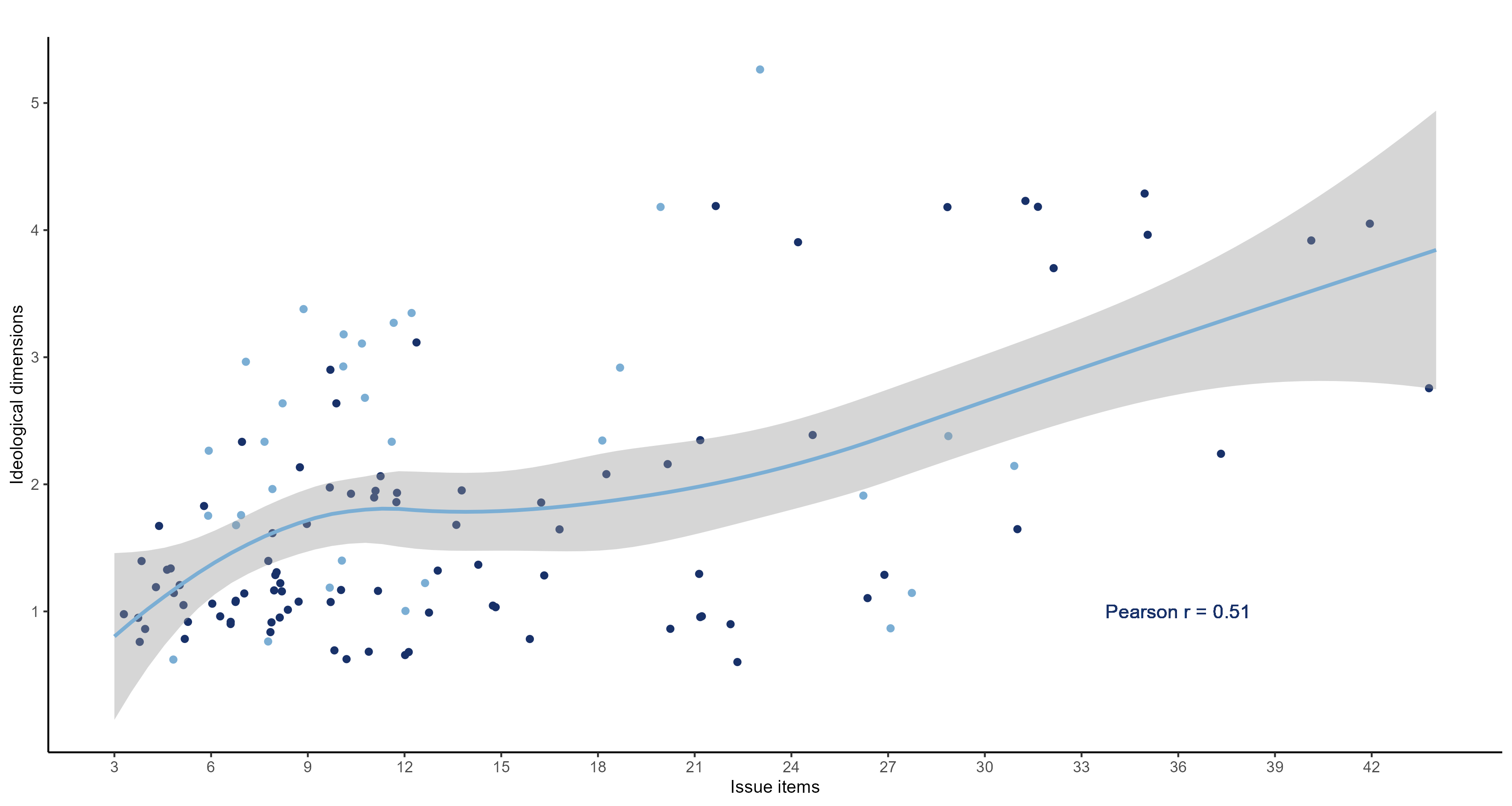Boundless but Bundled:
Modelling Quasi-infinite Dimensions in Ideological Space
Freie Universität Berlin & University of North Carolina at Chapel Hill p.warncke@fu-berlin.de
Utrecht University f.a.azevedo@uu.nl
2024-07-19
Which presidential candiate was closer to the median voter
Which presidential candiate was closer to the median voter in 2016?


Which presidential candiate was closer to the median voter in 2016?
Taking these issues into account:


Government spending
Abortion
Military budget
Number of dimensions: 1

Number of dimensions: 1
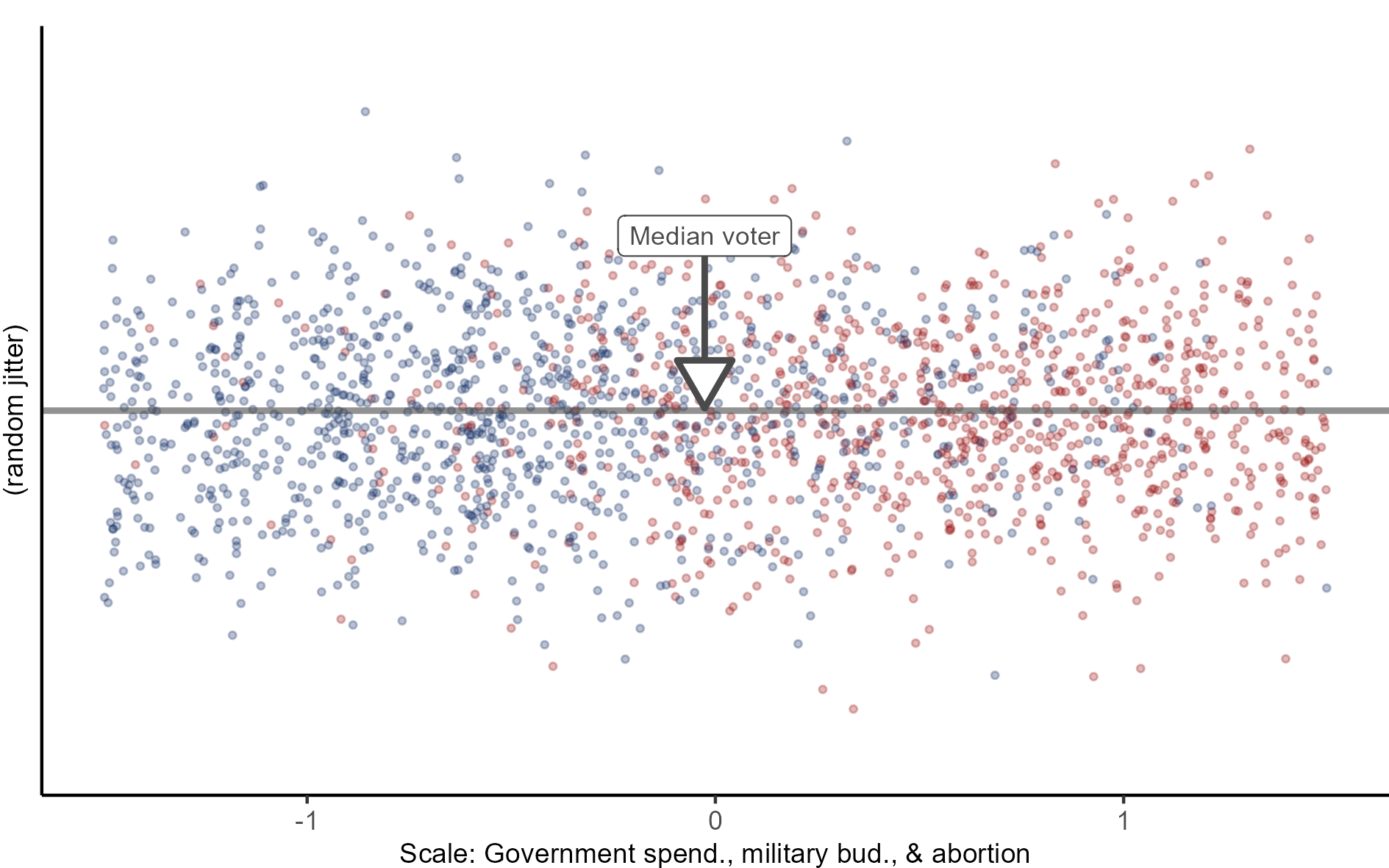
Number of dimensions: 1
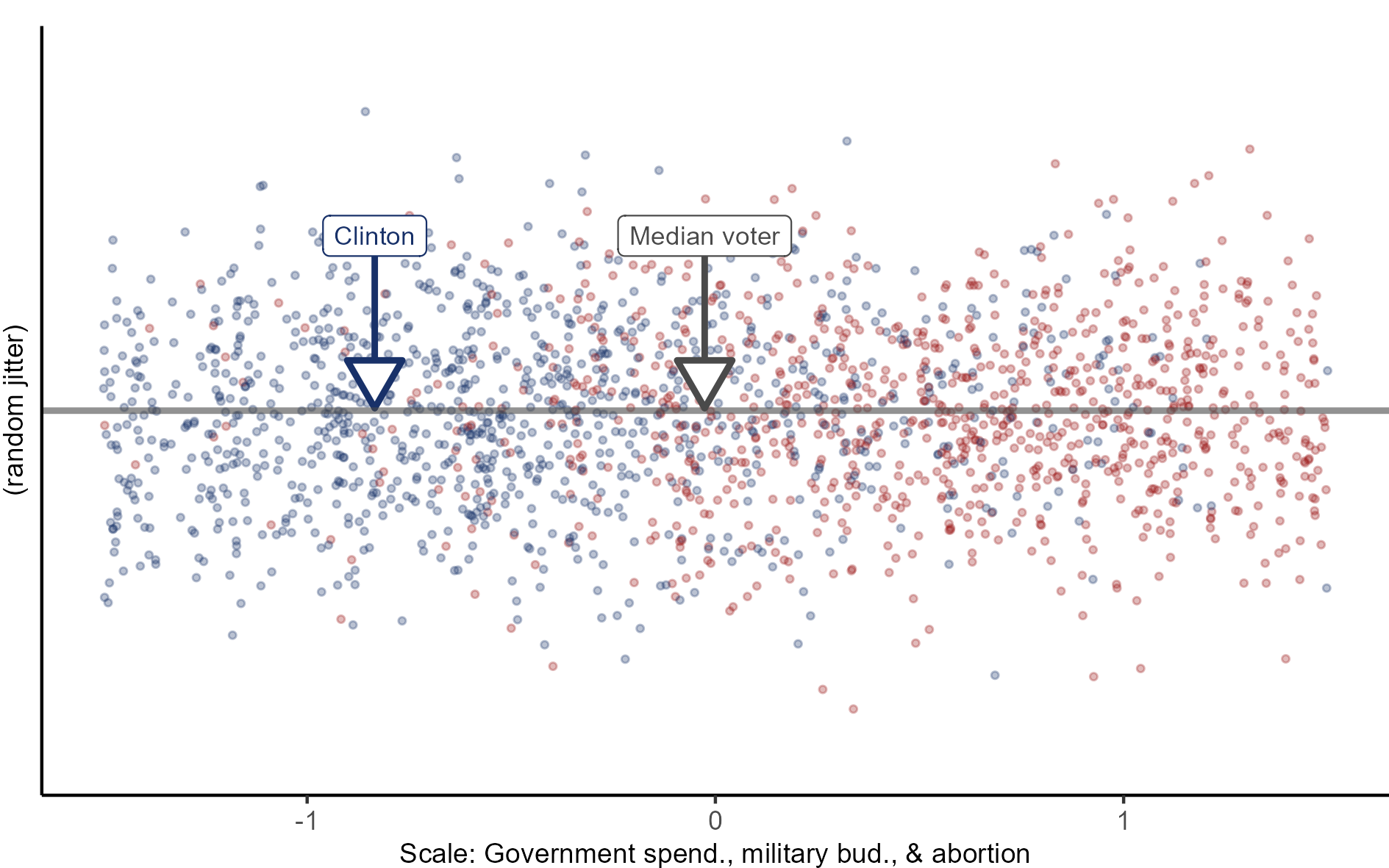
Number of dimensions: 1
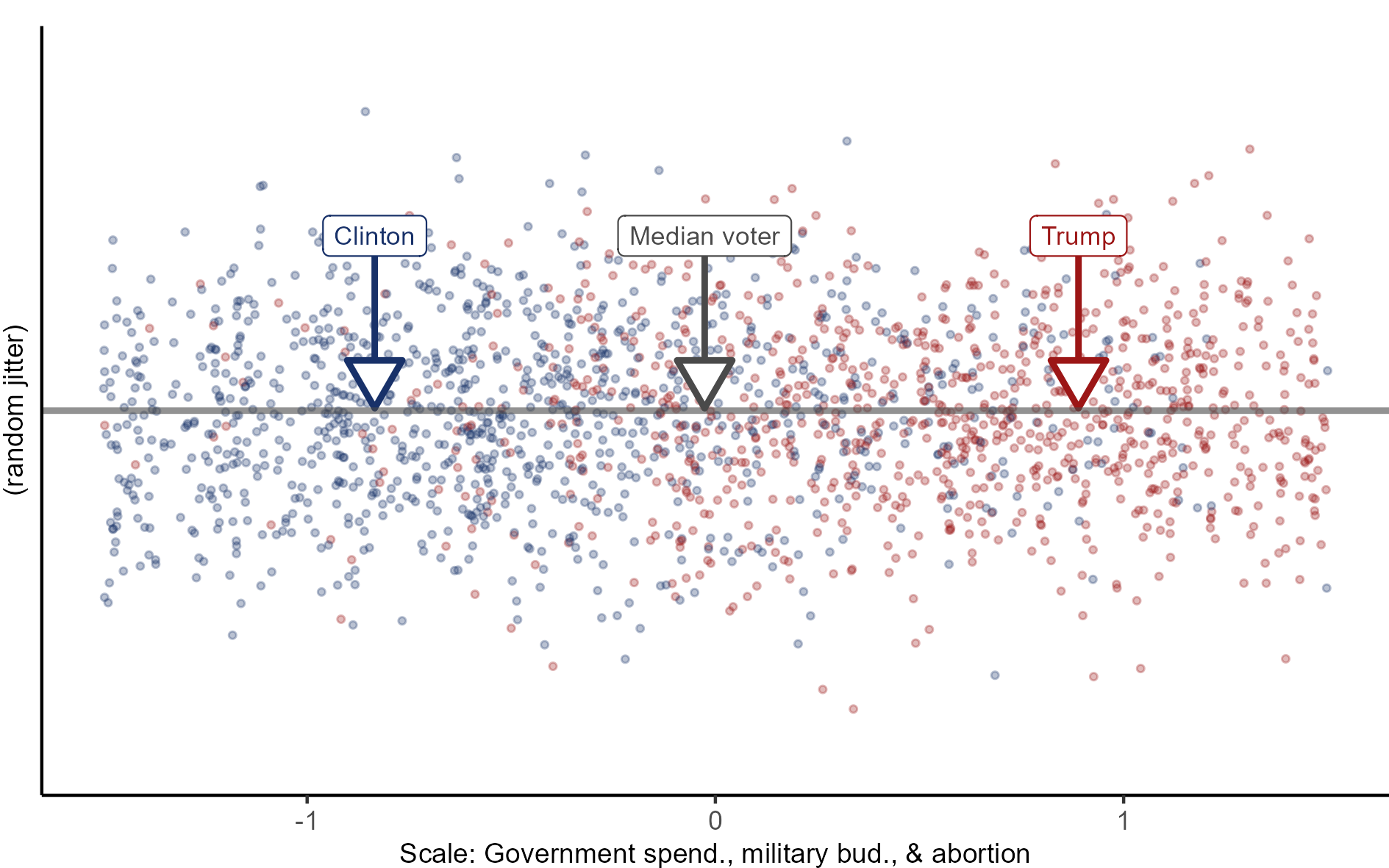
Number of dimensions: 1
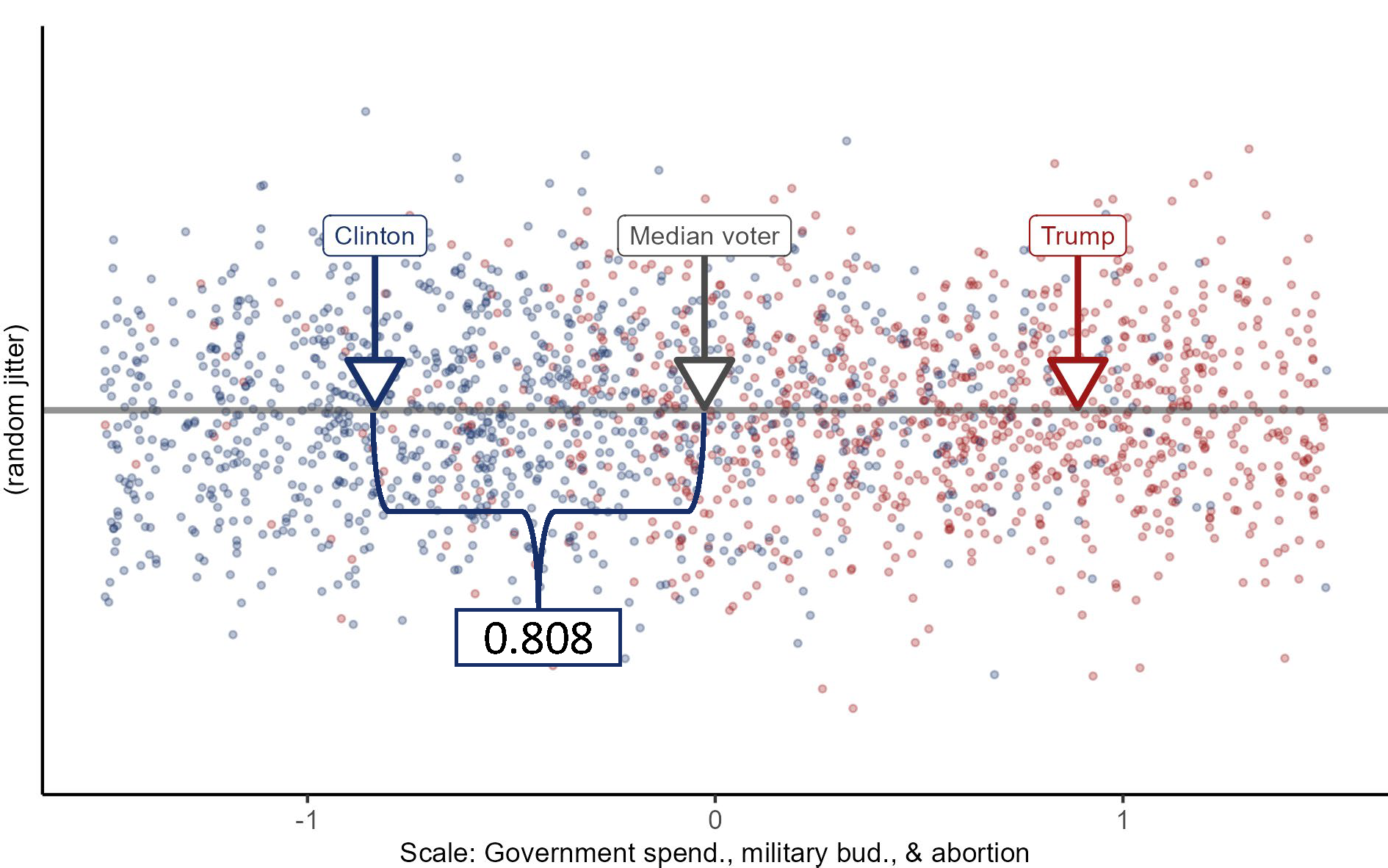
Number of dimensions: 1
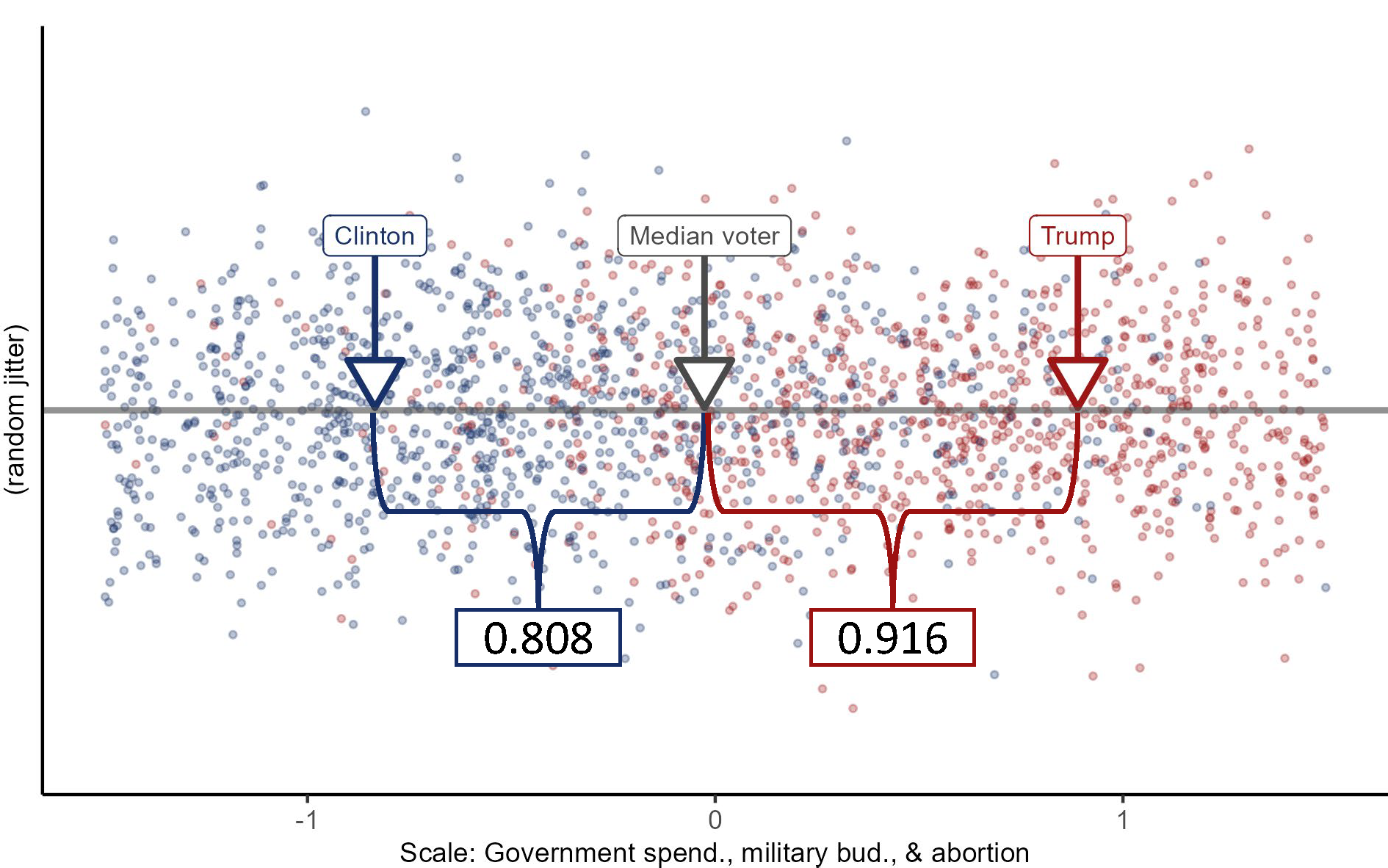
Number of dimensions: 2
Number of dimensions: 2
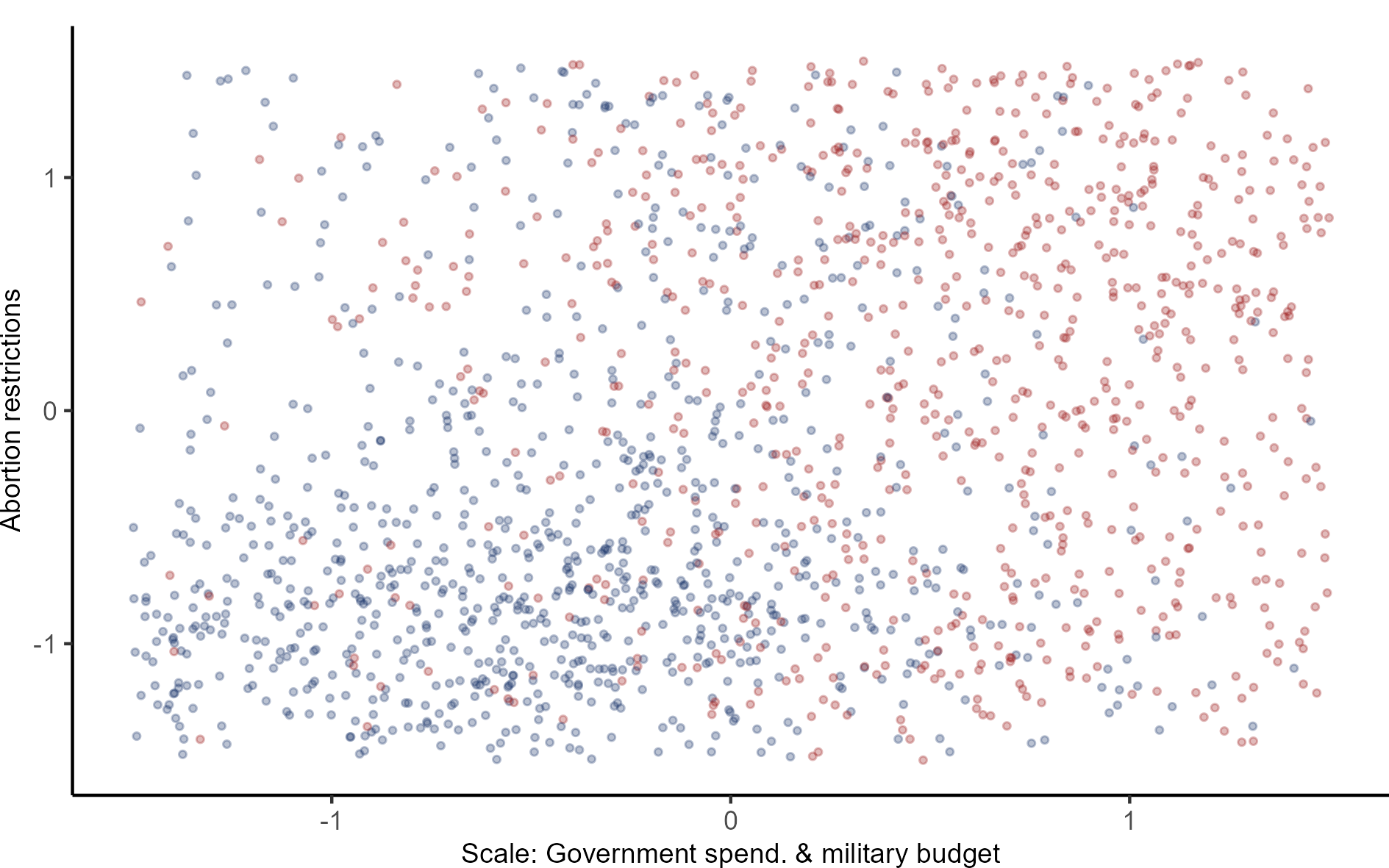
Number of dimensions: 2
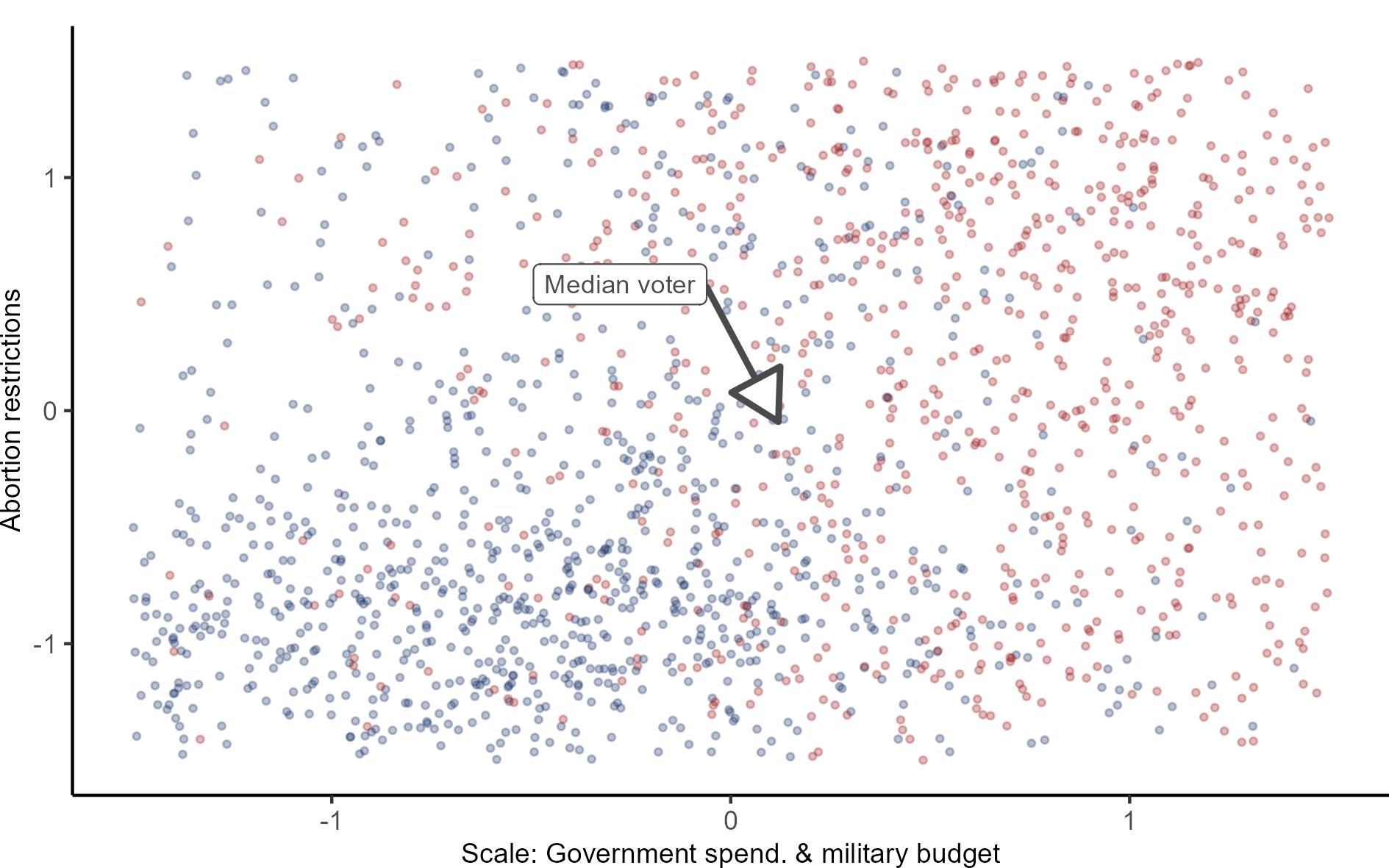
Number of dimensions: 2
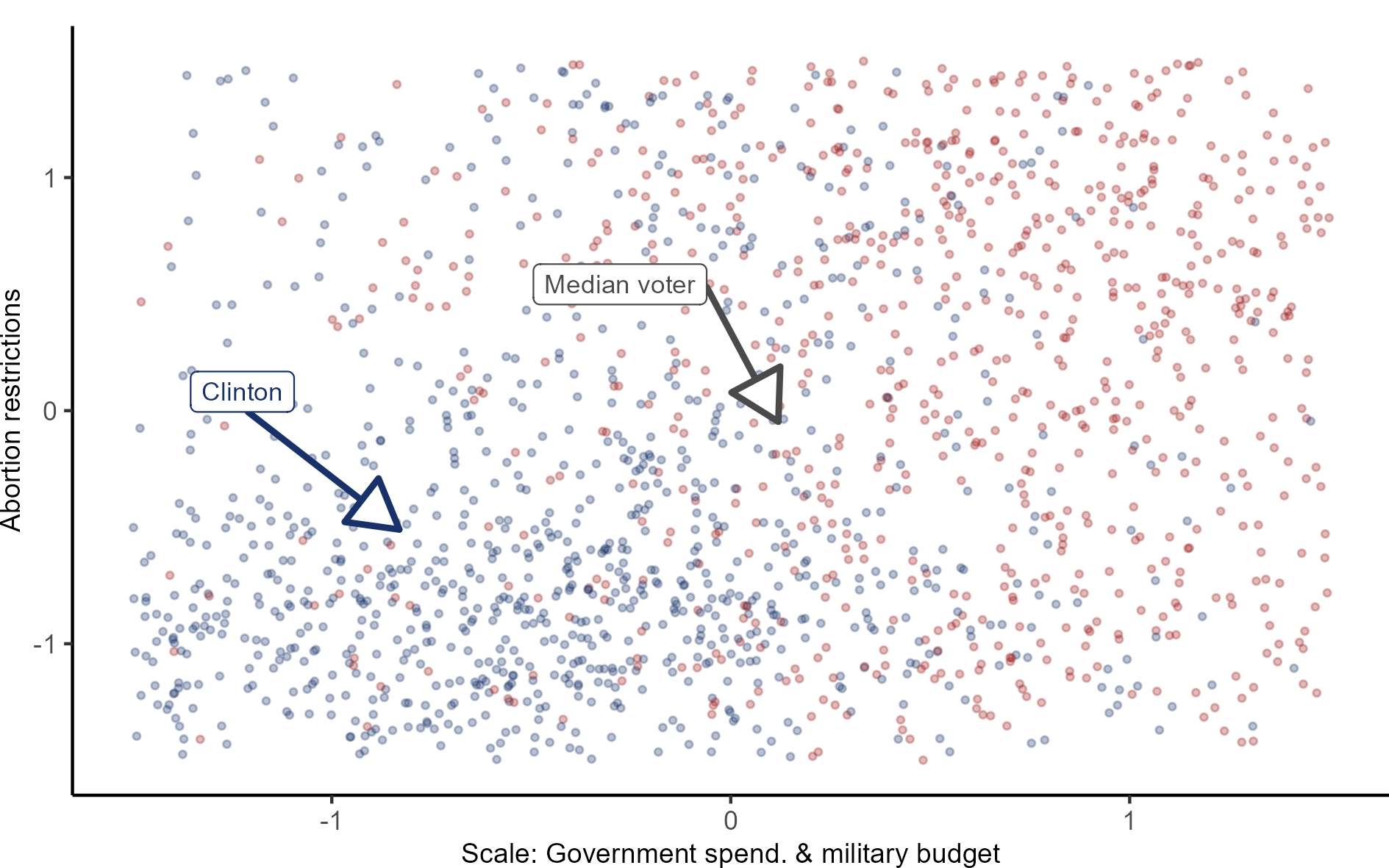
Number of dimensions: 2
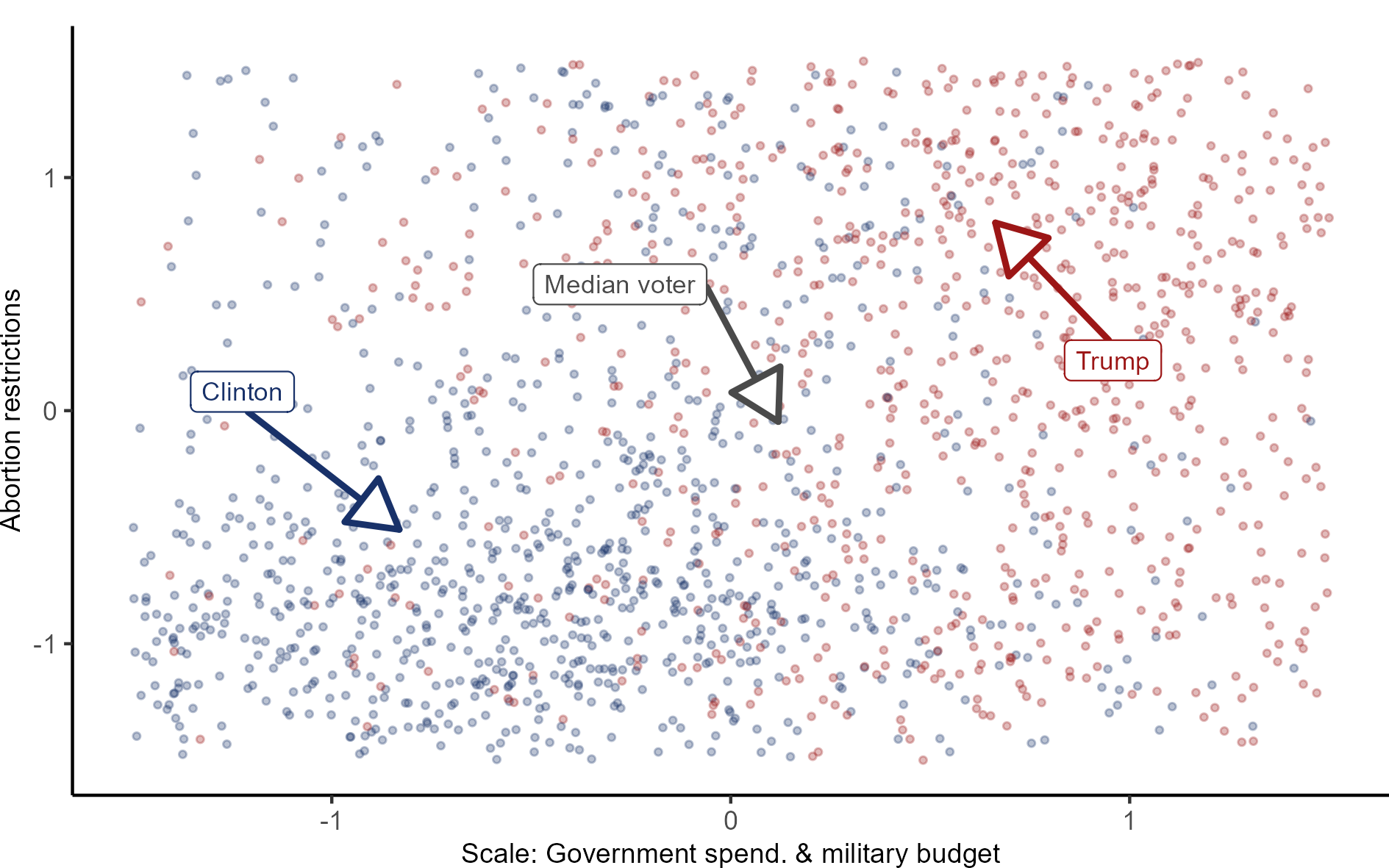
Number of dimensions: 2
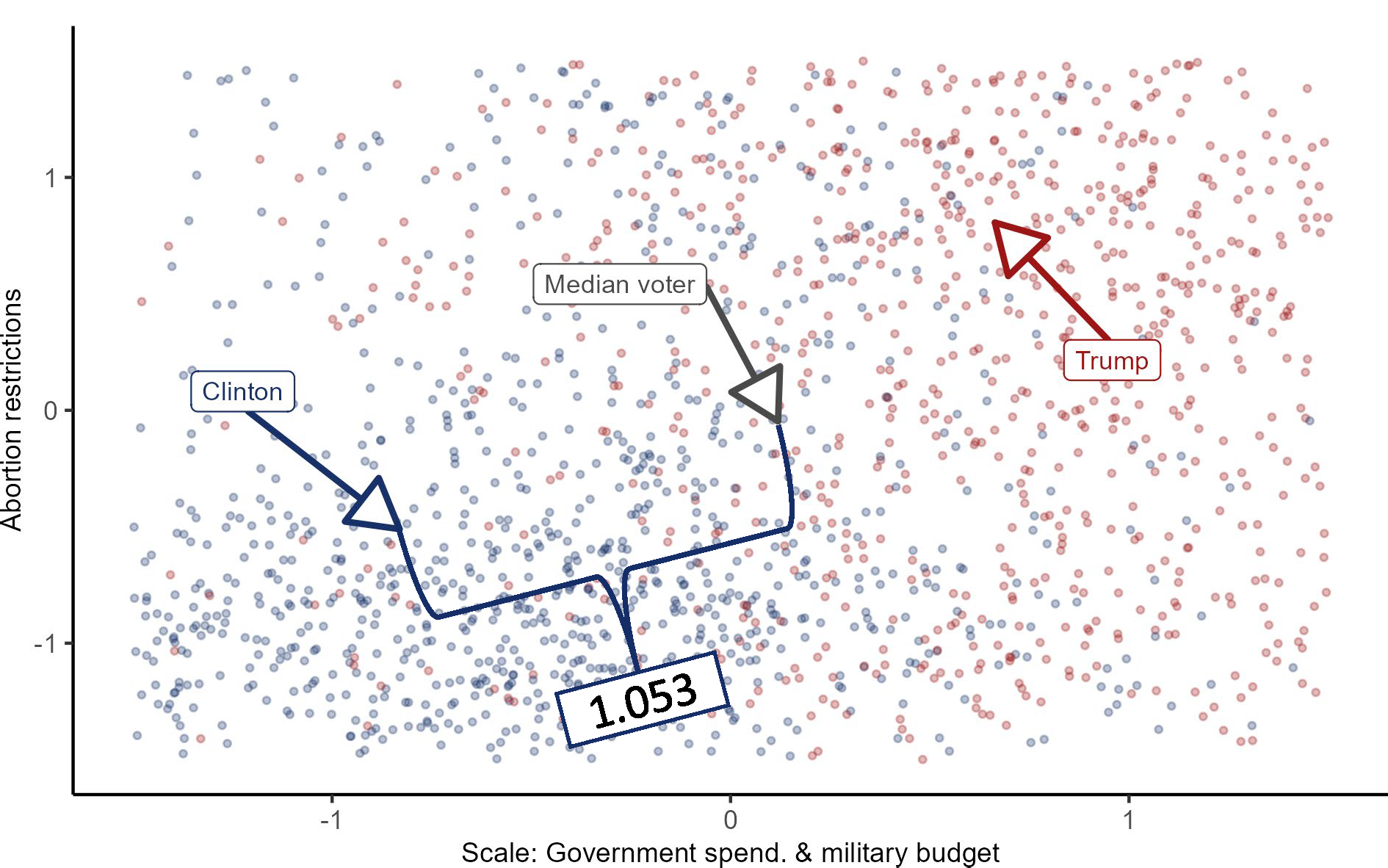
Number of dimensions: 2
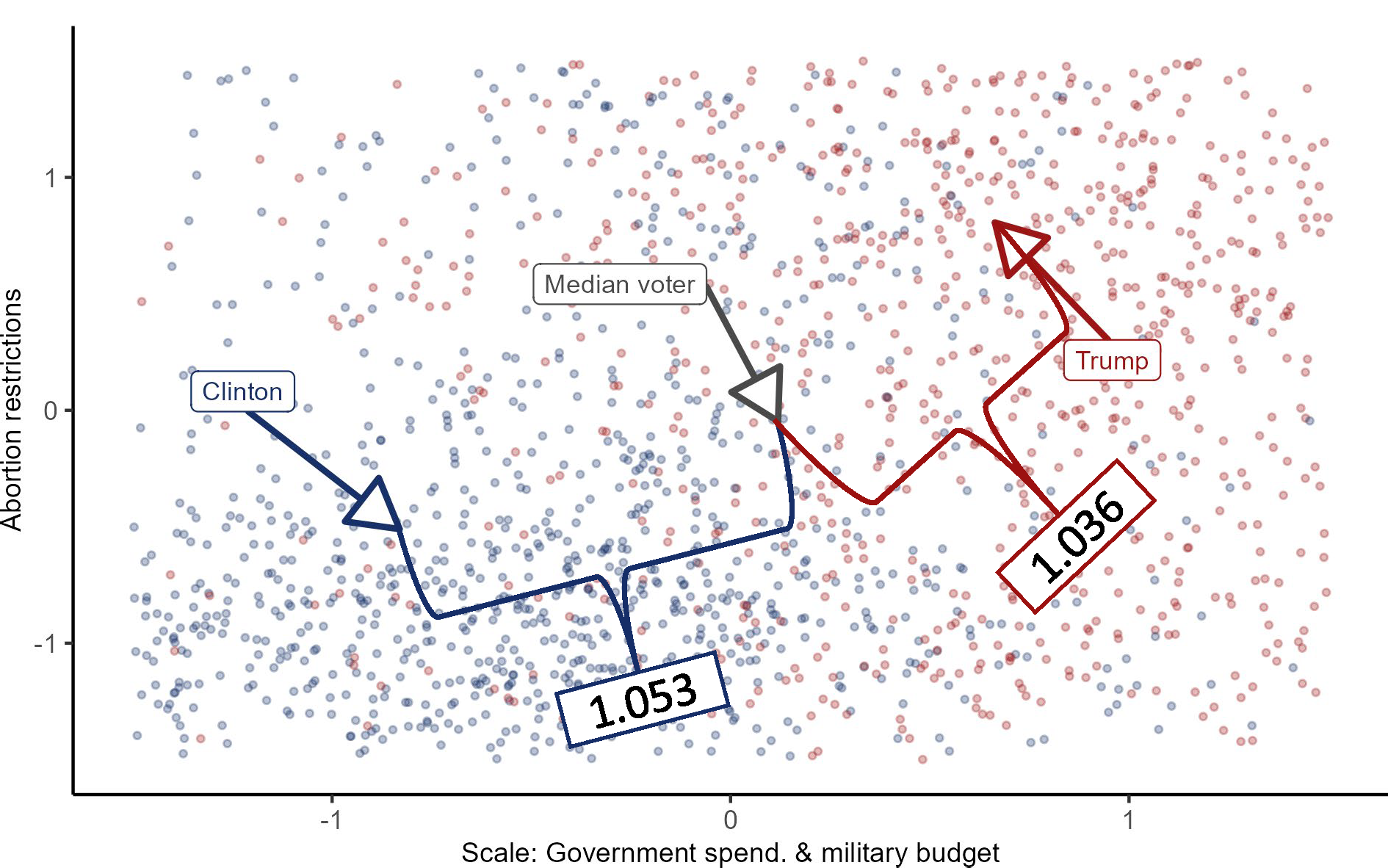
Number of dimensions: 3
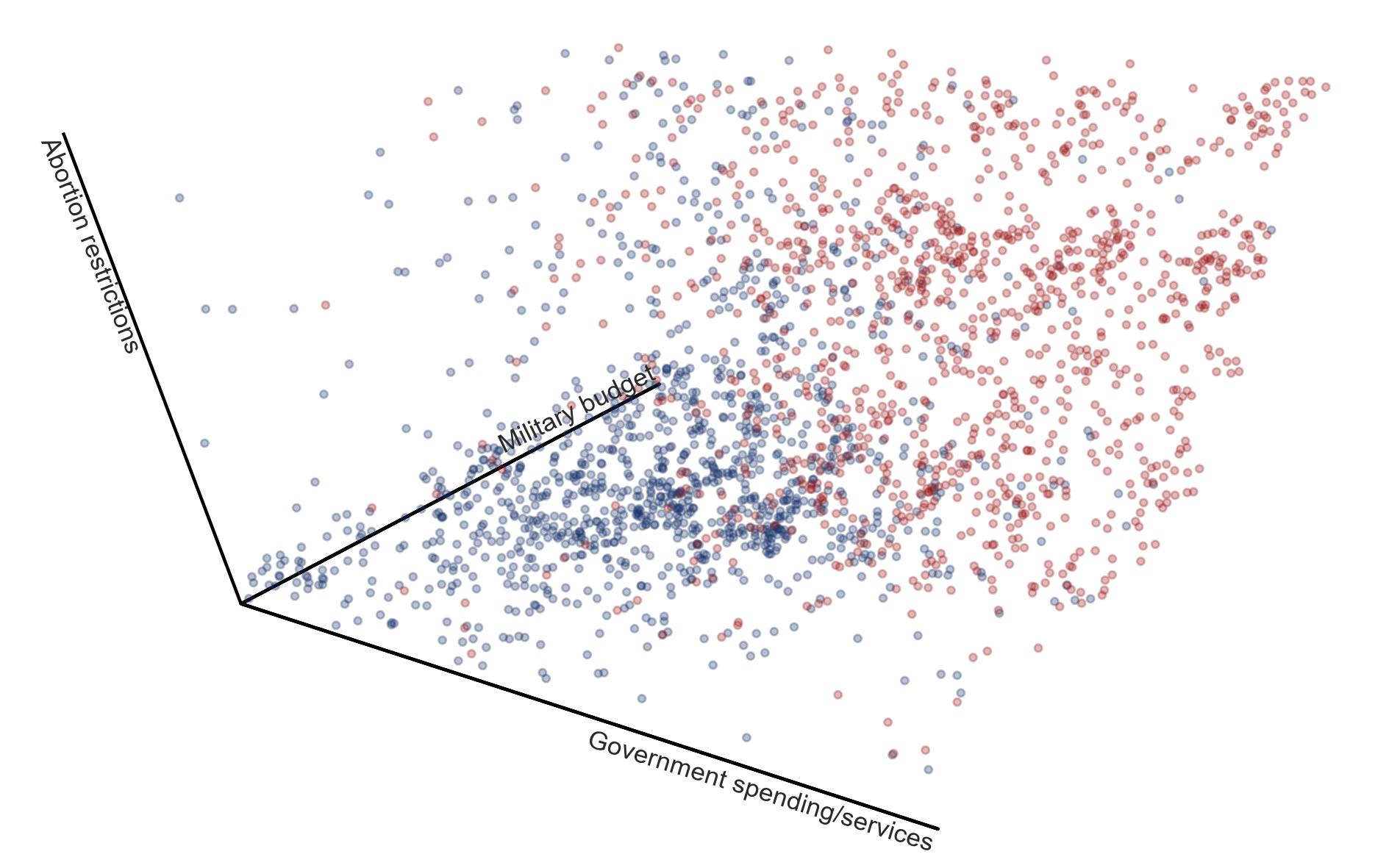
Number of dimensions: 3
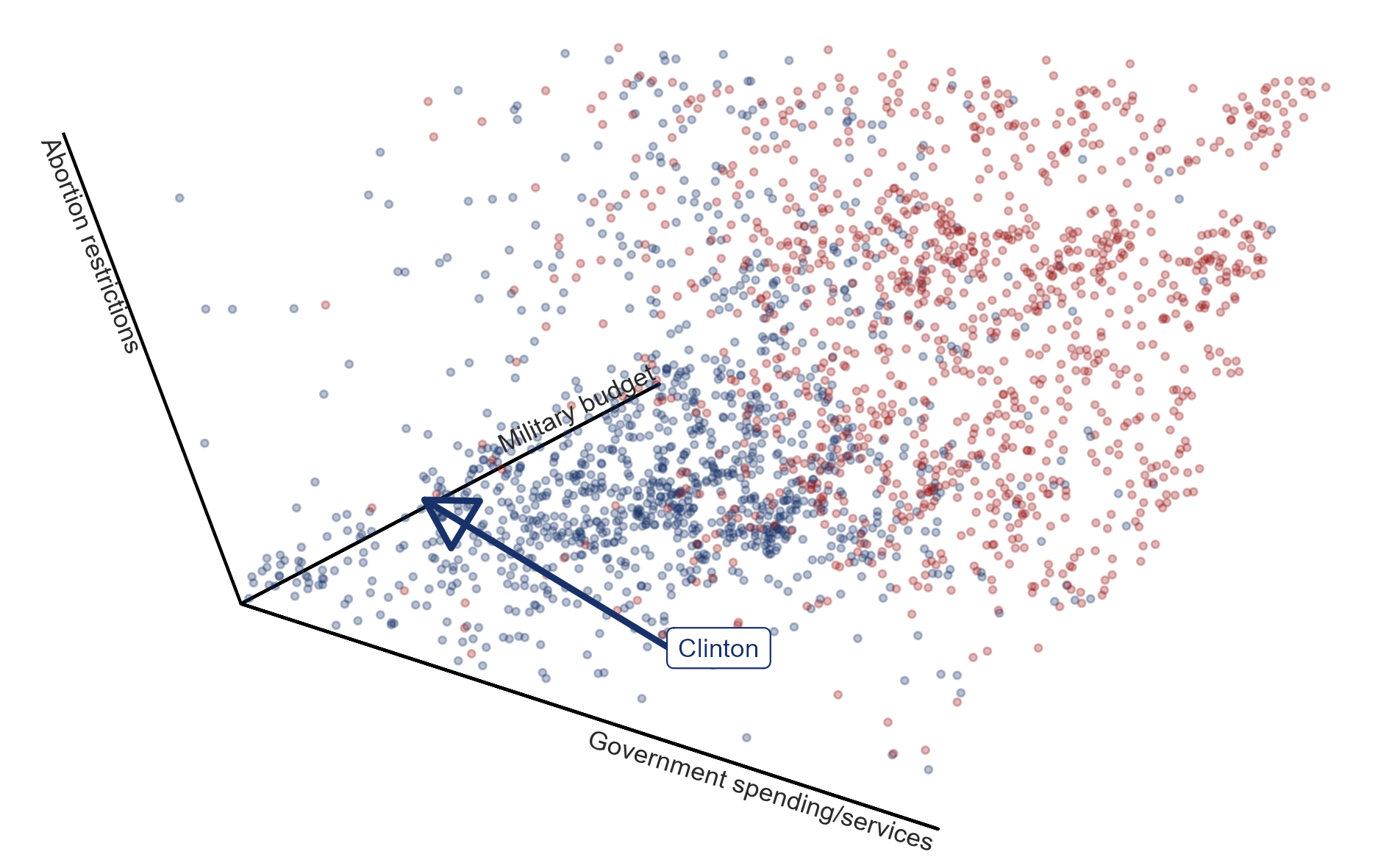
Number of dimensions: 3

Number of dimensions: 3

Number of dimensions: 3
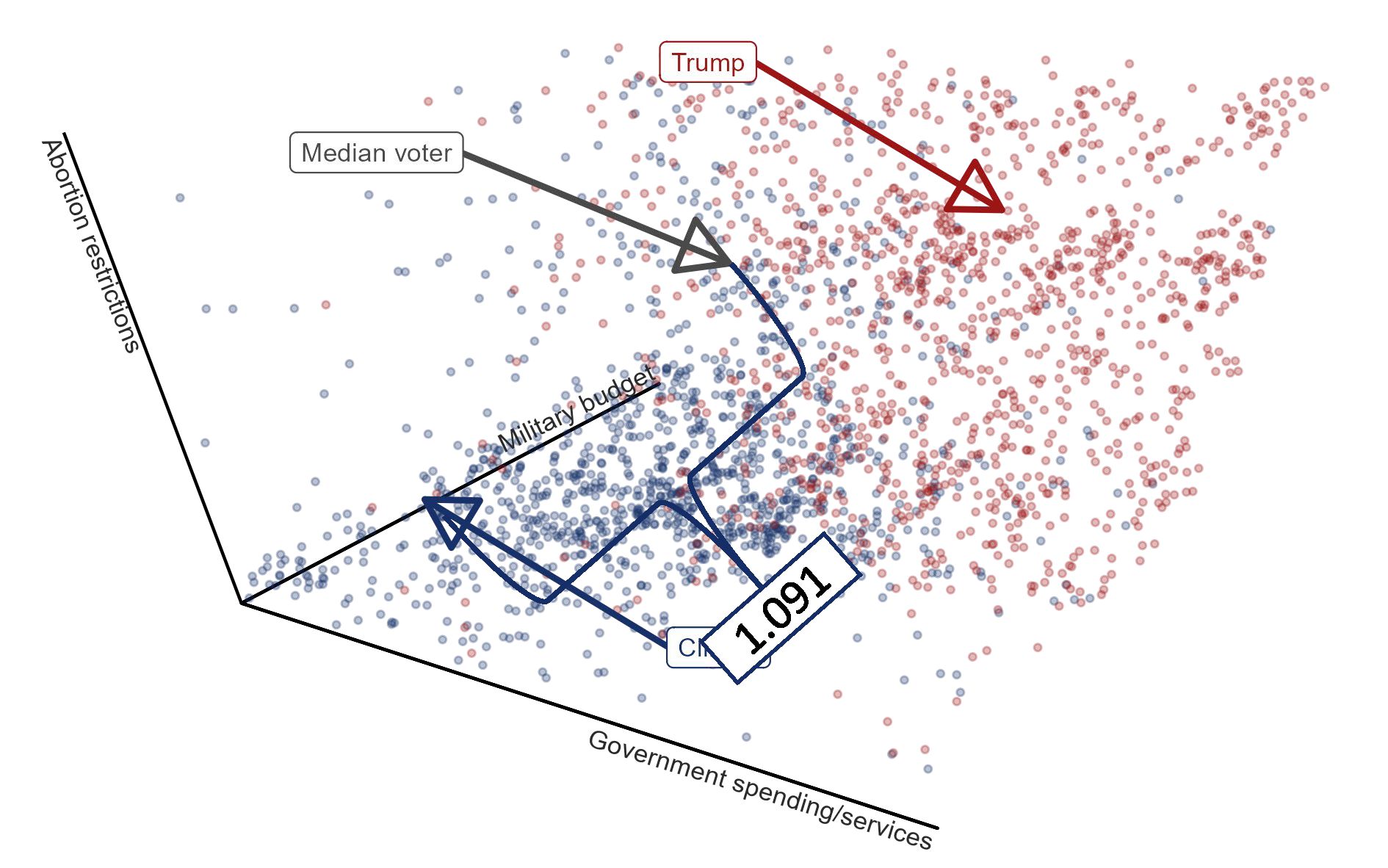
Number of dimensions: 3
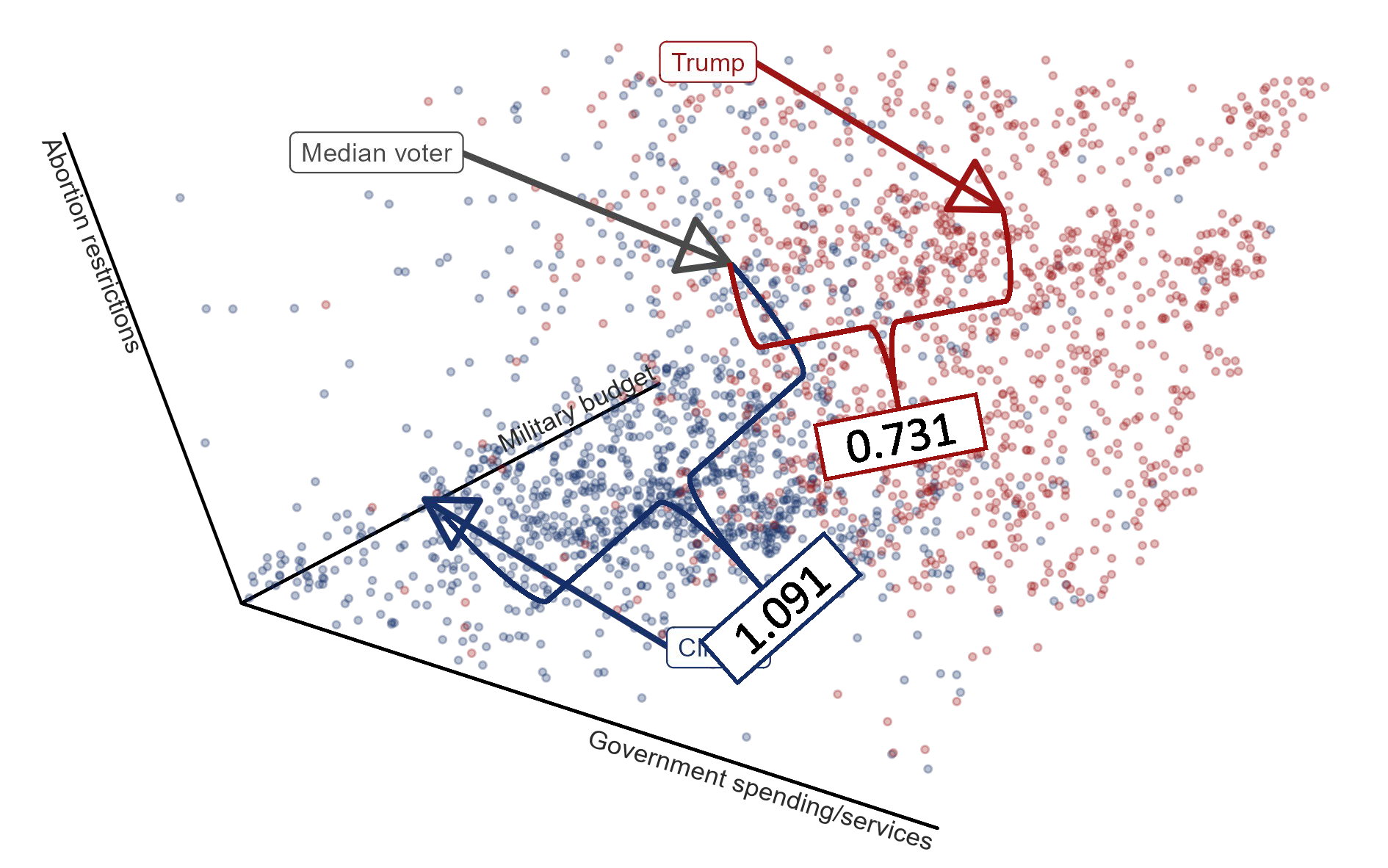
Consequences of model choices for dimensionality
Any measure of ideological distance requires a-priory assumptions about latent dimensionality
Lower-dimensional solutions up-weigh respondents conforming with hypothesized dimensions
Higher-dimensional solutions down-weigh respondents who follow general left-right ideology
Consequences of model choices for dimensionality
Any measure of ideological distance requires a-priory assumptions about latent dimensionality
Lower-dimensional solutions up-weigh respondents conforming with hypothesized dimensions
Higher-dimensional solutions down-weigh respondents who follow general left-right ideology
Downstream consequences for research on ideological sophistication, polarization, representation, …
The nature of ideological dimensionality
Political psychology: Along how many (if any) latent dimensions do people organize their political beliefs and preferences?
Political methodology: How many (if any) latent dimensions are required to adequately summarize people’s political beliefs and preferences?
The nature of ideological dimensionality
Political psychology: Along how many (if any) latent dimensions do people organize their political beliefs and preferences?
Political methodology: How many (if any) latent dimensions are required to adequately summarize people’s political beliefs and preferences?
Can we find an “objective” or “optimal” number of ideological dimensions to guide modeling choices?
“Optimal” dimensionality
Reckhase (1990): Dimensionality is the minimum number of mathematical variables needed to summarize a matrix of response data.
Seek to optimize \(d \leq K\) such that the particular set of latent factors, \(d_K\), likely generalizes beyond the immediate sample items \(K\).
If \(d_K\) is too large, we risk over-fitting the data by affording too much weight to idiosyncratic characteristics of the immediate sample.
If \(d_K\) is too small, we likely miss important features of the data-generating process leading to over-simplified theories and conclusions.
We rely on a Graph-based statistical machine learning simulation to find the optimal \(d\) for ideology.
Dimensionality simulation: basic set-up
Select a random policy position item bucket of size \(k\) from the ANES (2012)
Determine the optimal \(d_K\) latent dimensionality (via Exploratory graph analysis (EGA) or parallel analysis)
Exploratory graph analysis (Epskamp et.al. 2017)
From item set obtain a sparse correlation matrix via EBIC optimized Lasso
Find the community structure (via walk trap) with the lowest information entropy value
Number of communities is equal to number of latent dimensions; community membership determines loading patterns
Exploratory graph analysis (Epskamp et.al. 2017)
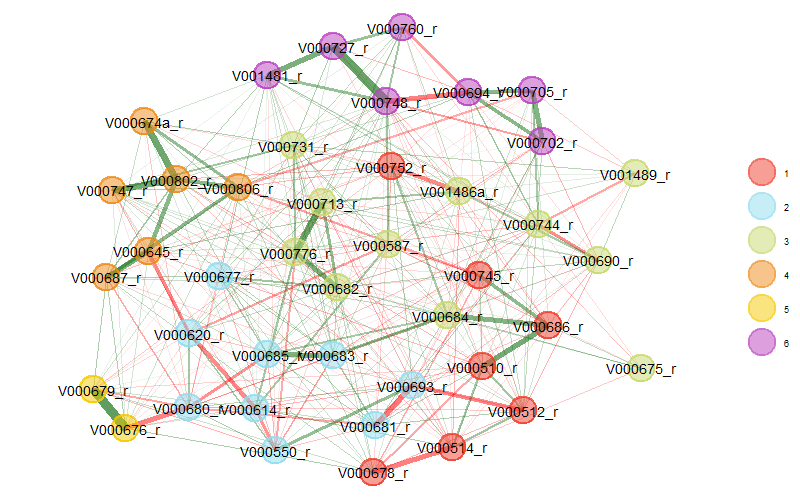
Dimensionality simulation: basic set-up
Select a random policy position item bucket of size \(k\) from the ANES (2012)
Determine the optimal \(d_K\) latent dimensionality (via Exploratory graph analysis (EGA) or parallel analysis)
Fit a factor model and extract model fit statistics
Dimensionality simulation: basic set-up
Select a random policy position item bucket of size \(k\) from the ANES (2012)
Determine the optimal \(d_K\) latent dimensionality (via Exploratory graph analysis (EGA) or parallel analysis)
Fit a factor model and extract model fit statistics
Repeat the process while incrementing \(k\)
Ideology: Item bucket size & latent dimensionality
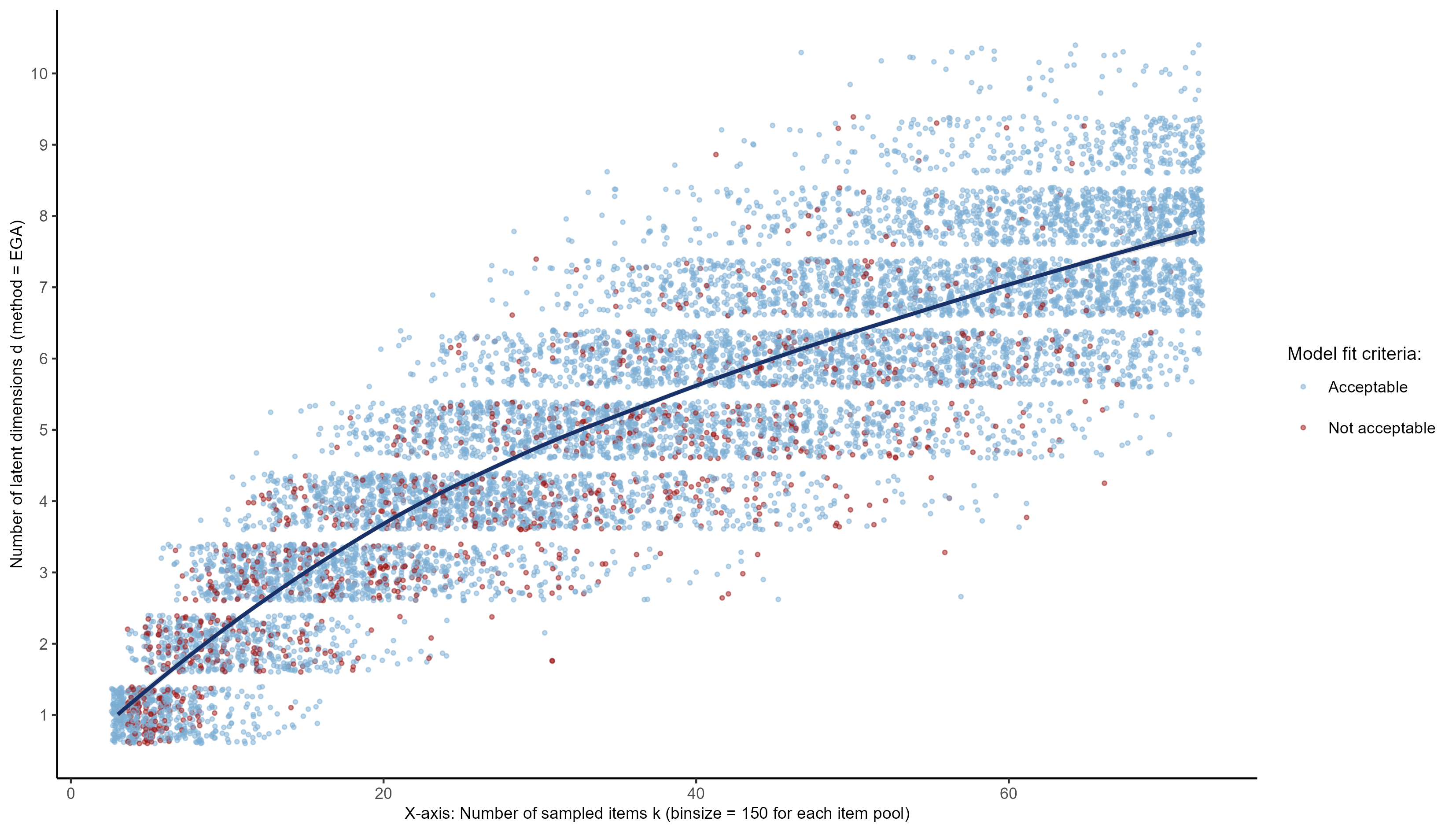
Dimensionality simulation results
Ideological dimensionality, measured with policy position items, grows without bound as researchers add more and more items to their models
Dimensionally indeterminate nature of mass ideology means that no objective standards for “optimal” number of dimensions exist
Bad news for empirical models of ideology …
Robustness check: Parallel analysis

Robustness check: 2018 CCES
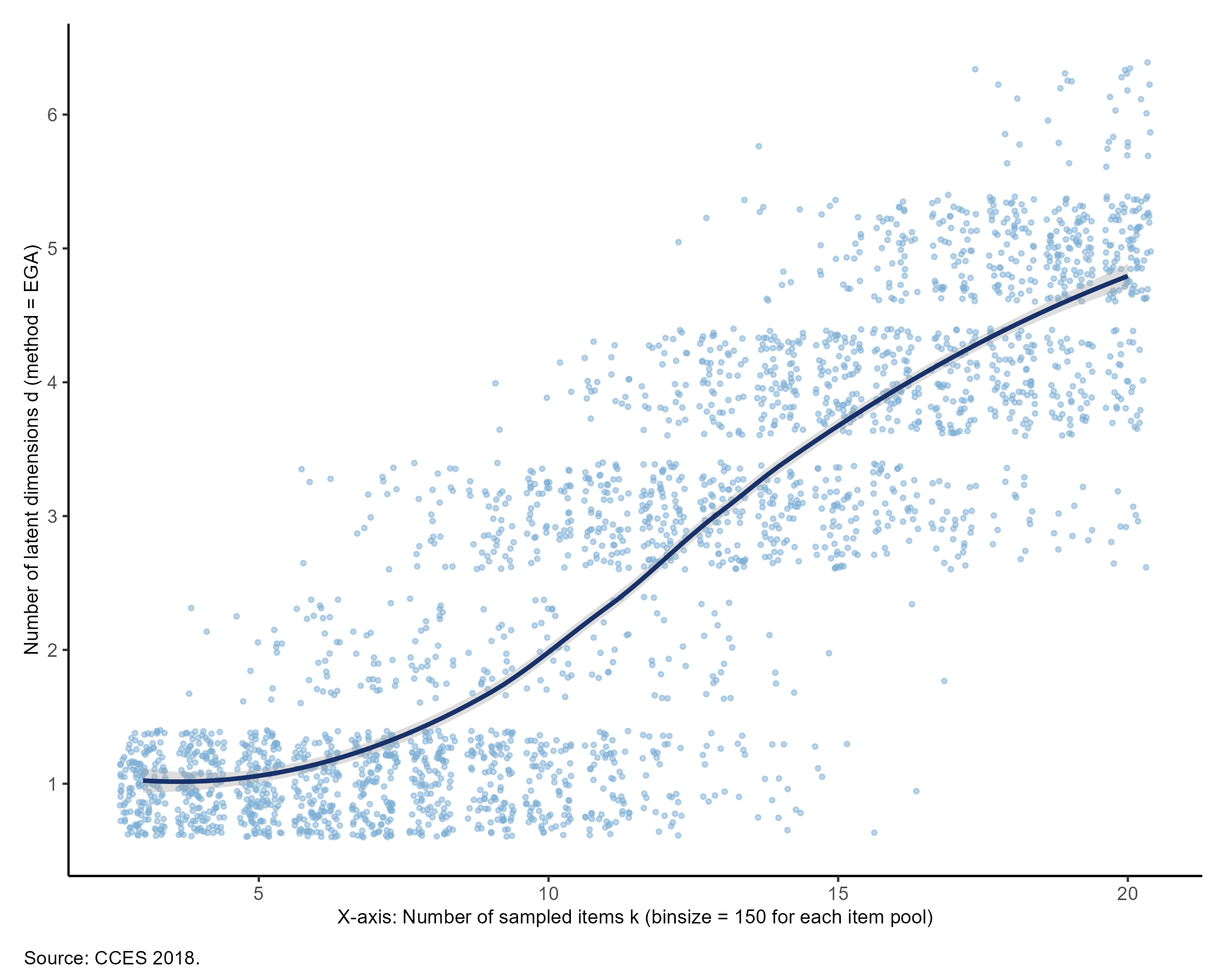
Robustness check: 2000 ANES
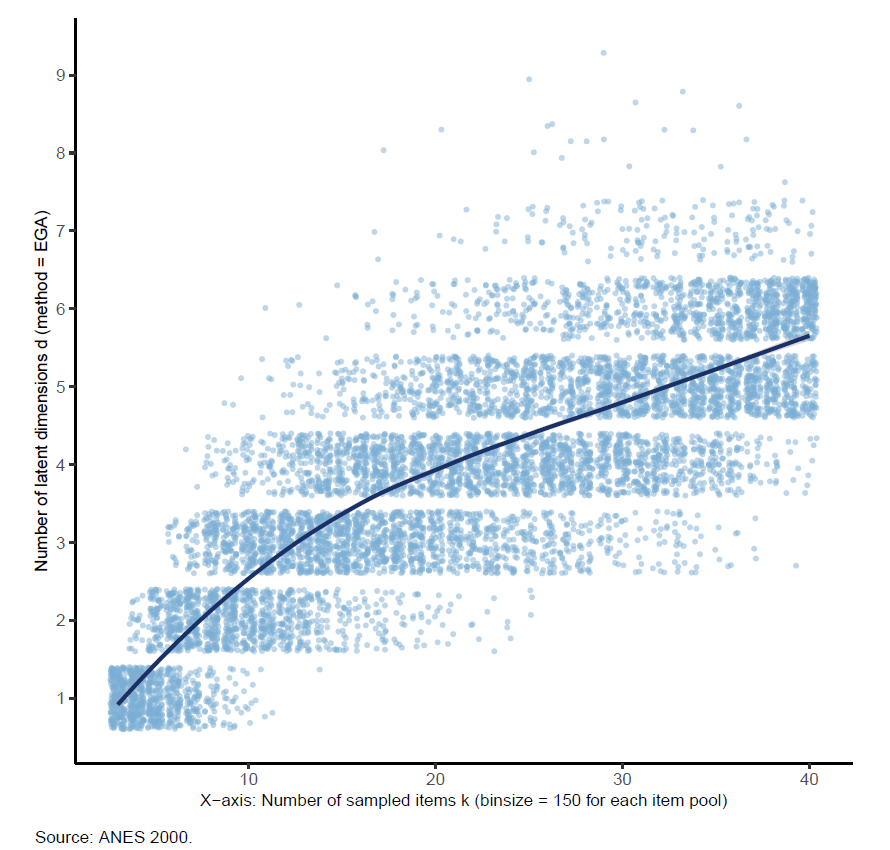
Robustness check: 2020 ANES
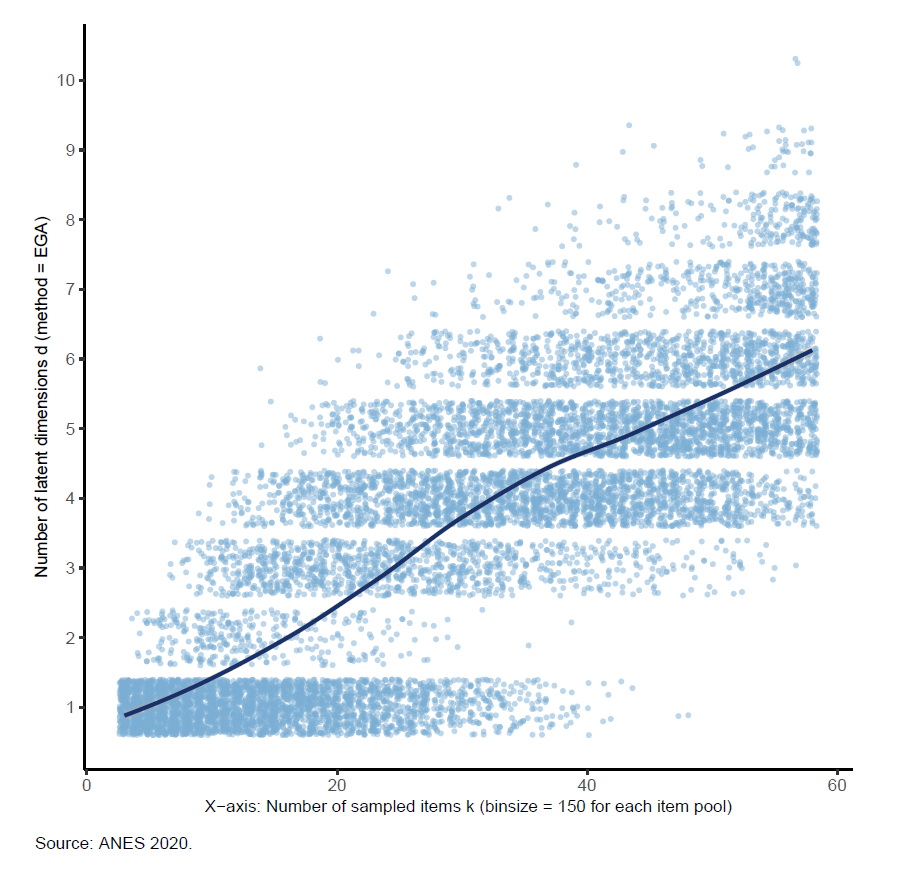
Robustness check: Personality
Compare results to psychometrically “better behaved” constructs like personality
Supplied data on “Big-5” Personality battery with 48 items to same dimensionality detection method
Robustness check: Personality
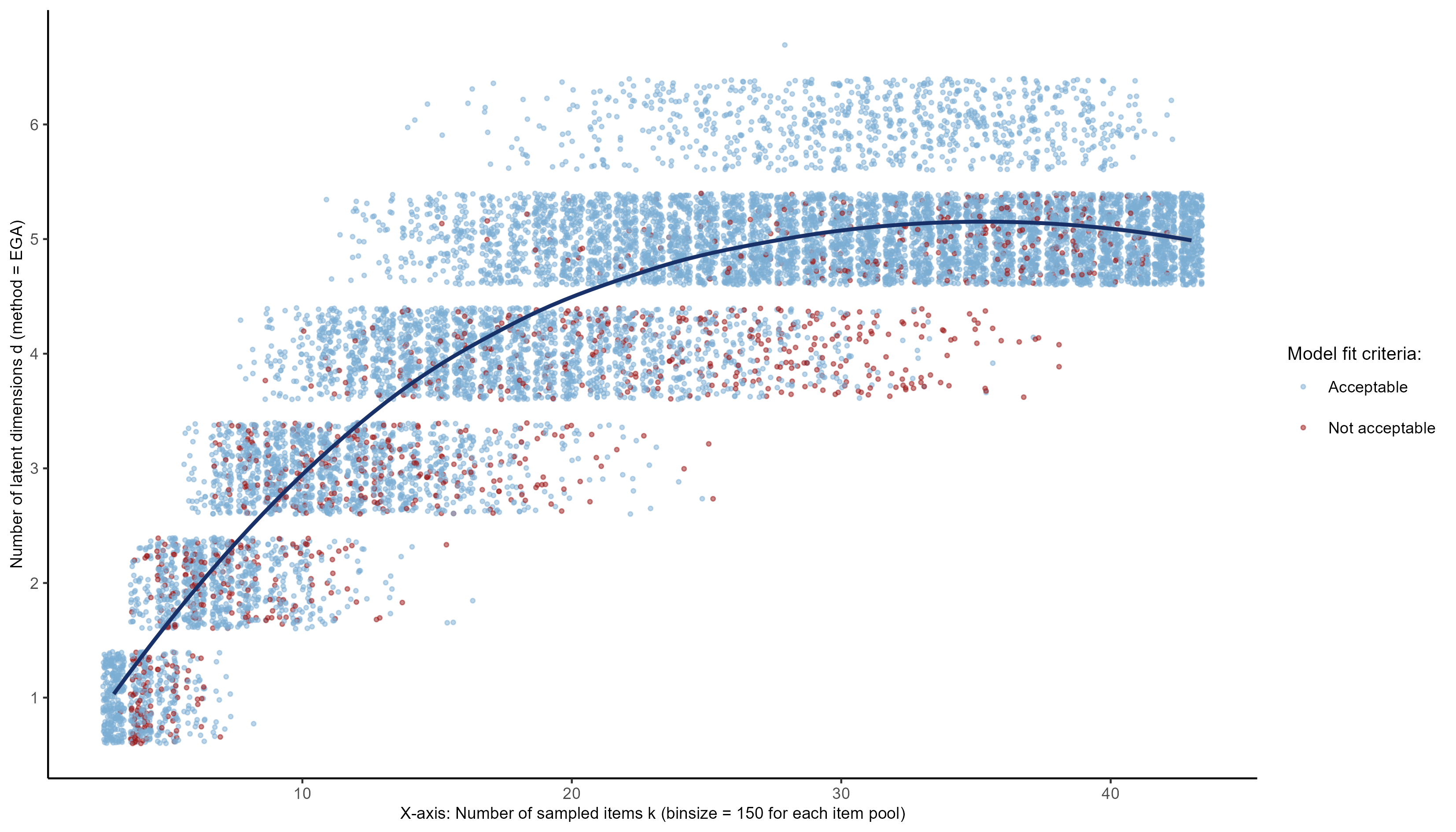
Shimmer of hope: Consistent latent factor correlation
- In contrast to personality, we find very consistent evidence for moderately-sized, positive correlations among all latent ideology factors
Shimmer of hope: Consistent latent factor correlation
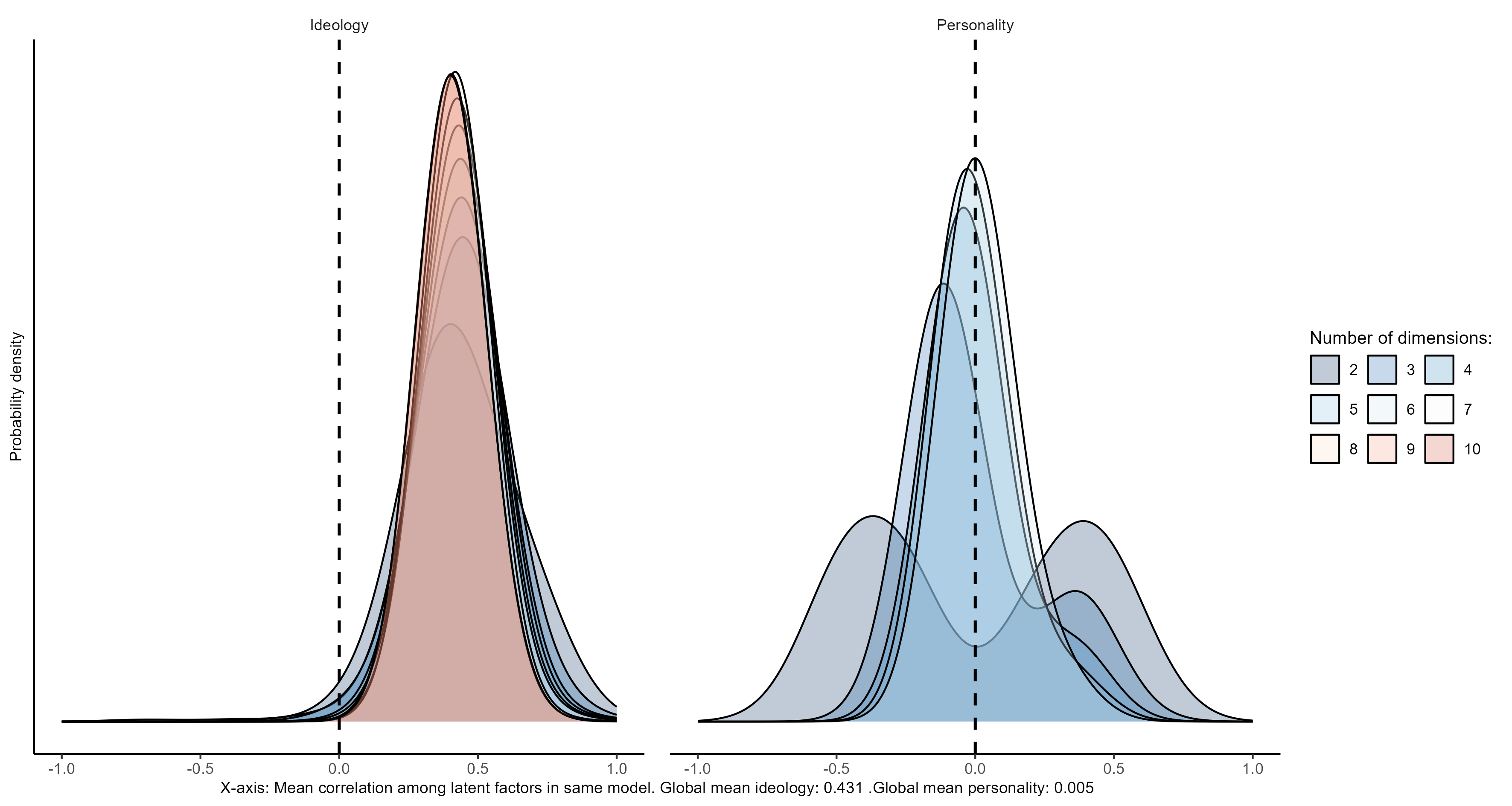
Shimmer of hope: Consistent latent factor correlation
In contrast to personality, we find very consistent evidence for moderately-sized, positive correlations among all latent ideology factors
Ideology data is not hopelessly chaotic but possesses some degree of structure at a higher (more abstract) order
Dimensionality simulation results
Ideological dimensionality, measured with policy position items, grows without bound as researchers add more and more items to their models
Dimensionally indeterminate nature of mass ideology means that no objective standards for “optimal” number of dimensions exist
However, almost all latent ideological dimensions are positively and sizably correlated with one another
Dimensionality simulation results
Ideological dimensionality, measured with policy position items, grows without bound as researchers add more and more items to their models
Dimensionally indeterminate nature of mass ideology means that no objective standards for “optimal” number of dimensions exist
However, almost all latent ideological dimensions are positively and sizably correlated with one another
Need a flexible modeling framework that can handle arbitrary number of dimensions while accounting for partial alignment of these
Alternative approach: Bayesian hyper-factor model
We can treat latent ideology in a hierarchical modeling framework to account for the consistent correlation between sub-dimensions
Inductively determine optimal number of sub-dimensions
Specify an overarching factor explaining partial alignment among all sub-dimensions
Reasonably informative priors enable simultaneous estimation of latent constructs and external predictors
- E.g. partisanship, ideological identity, authoritarianism, age, race, gender, etc.
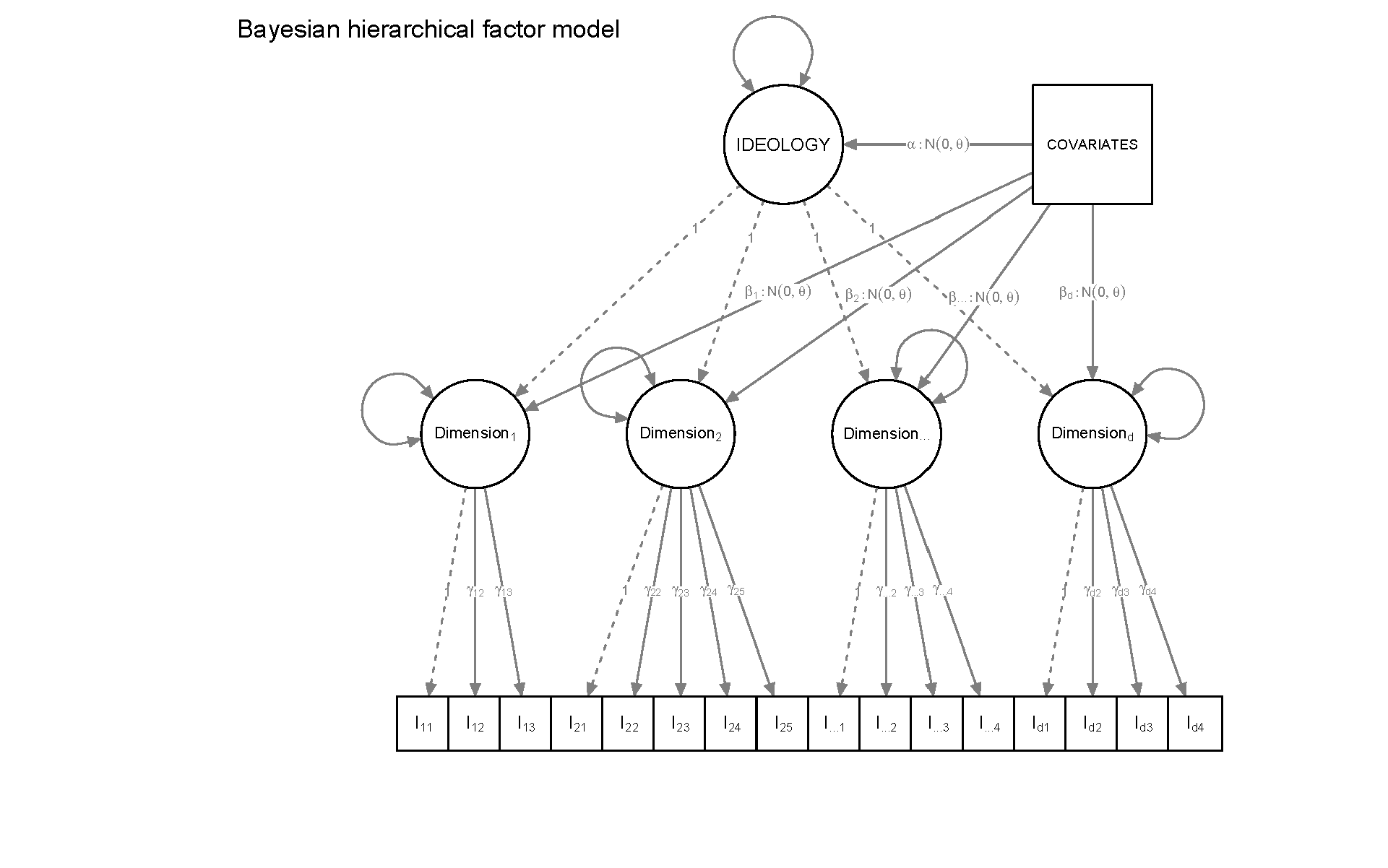
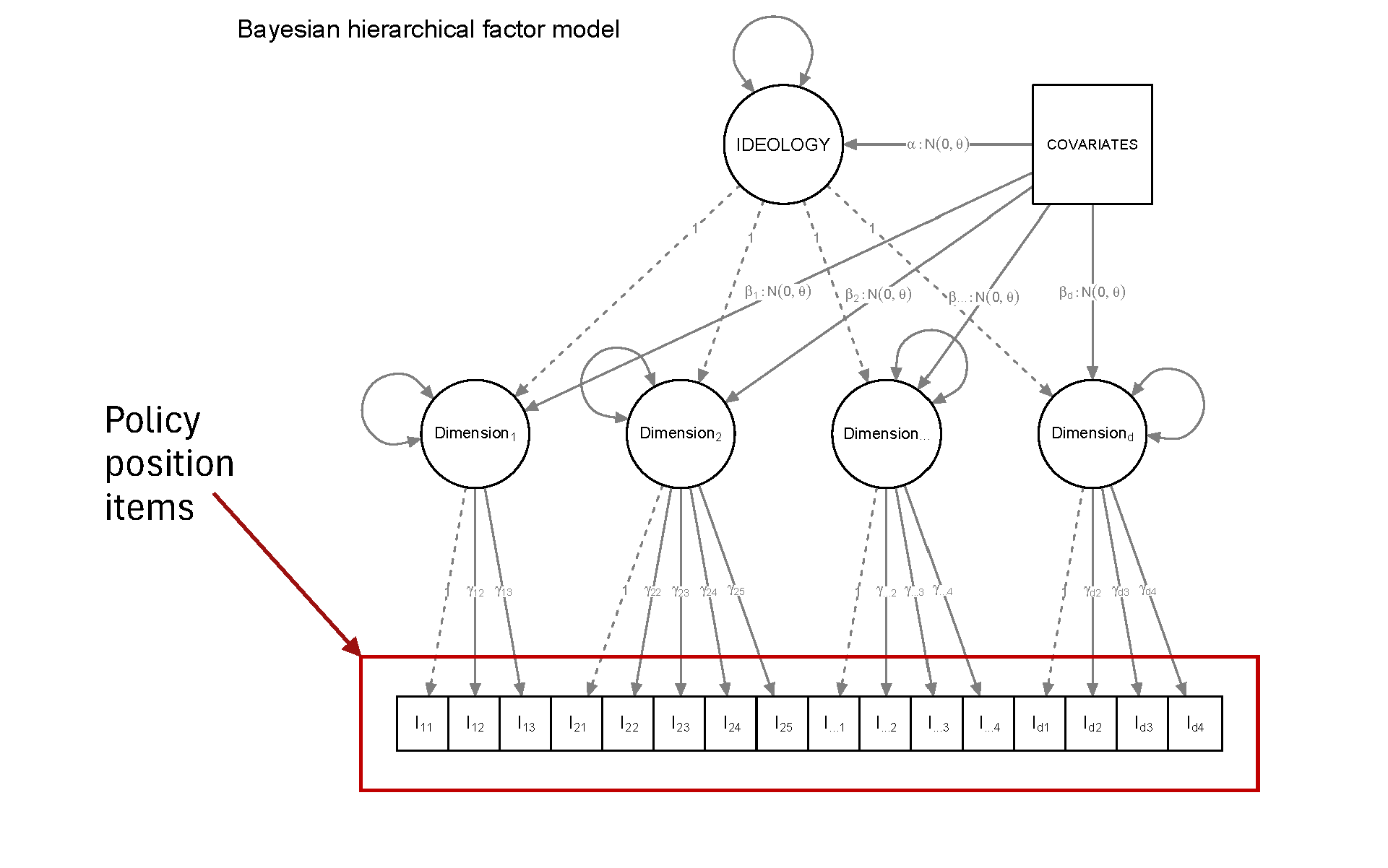
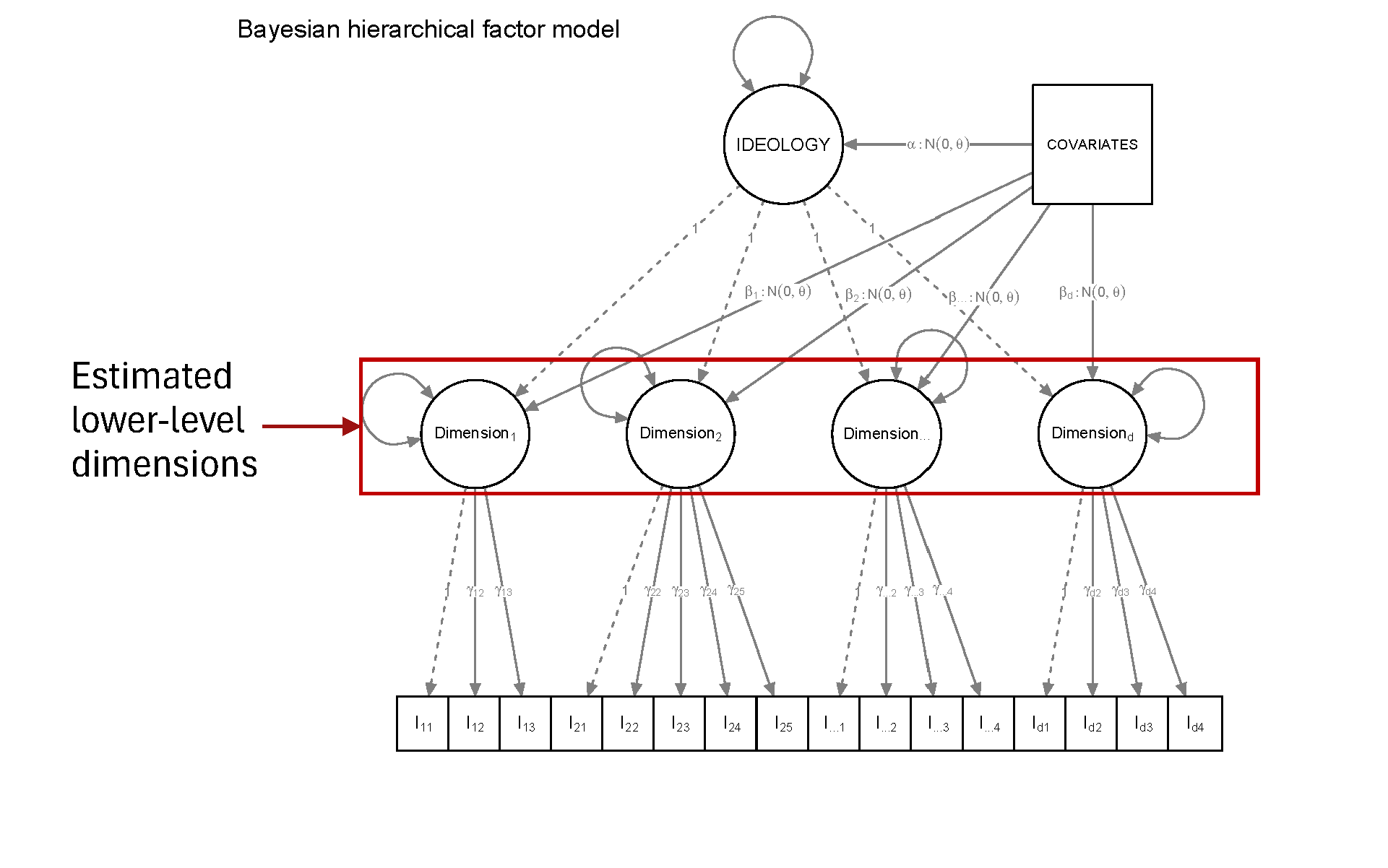

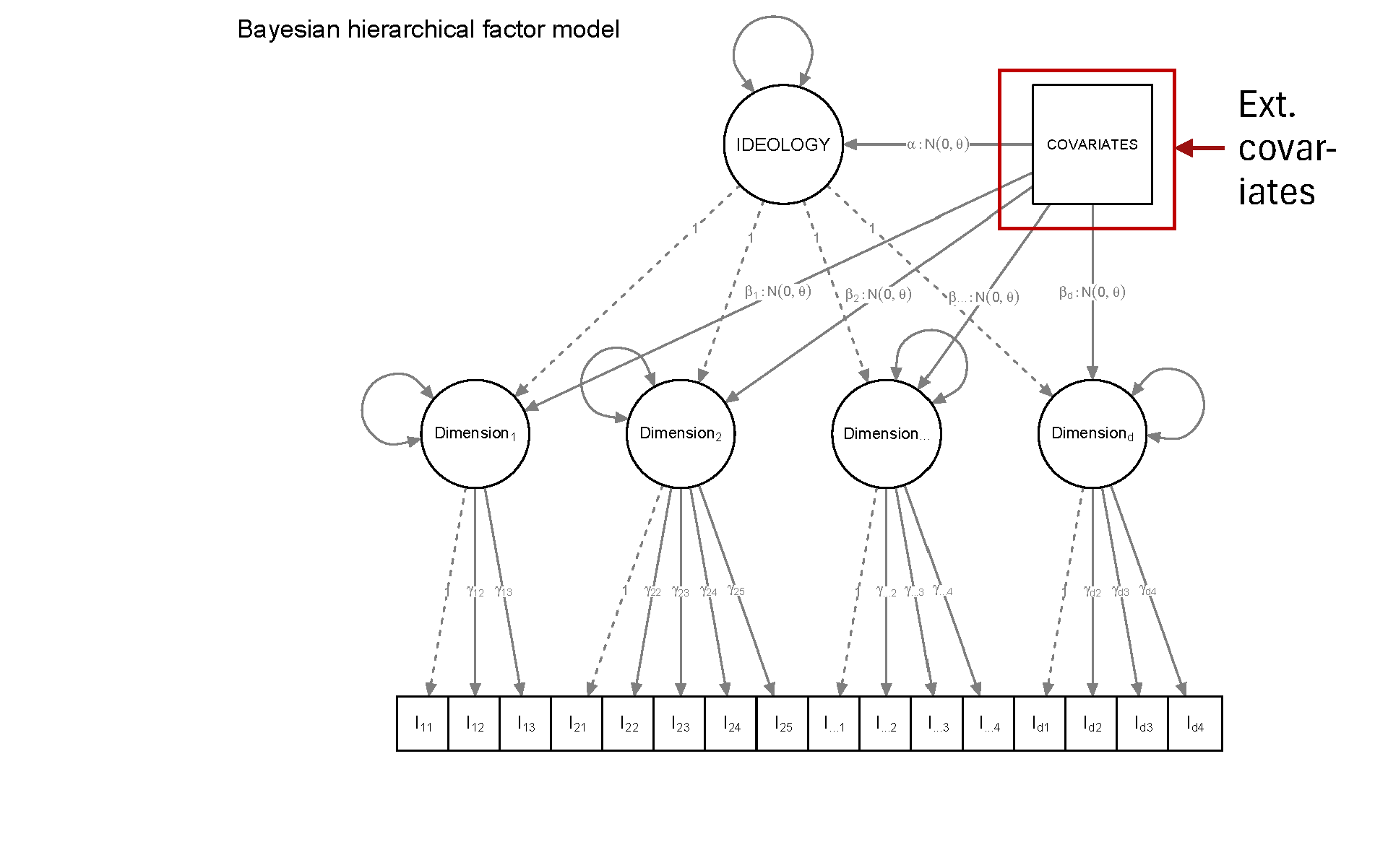
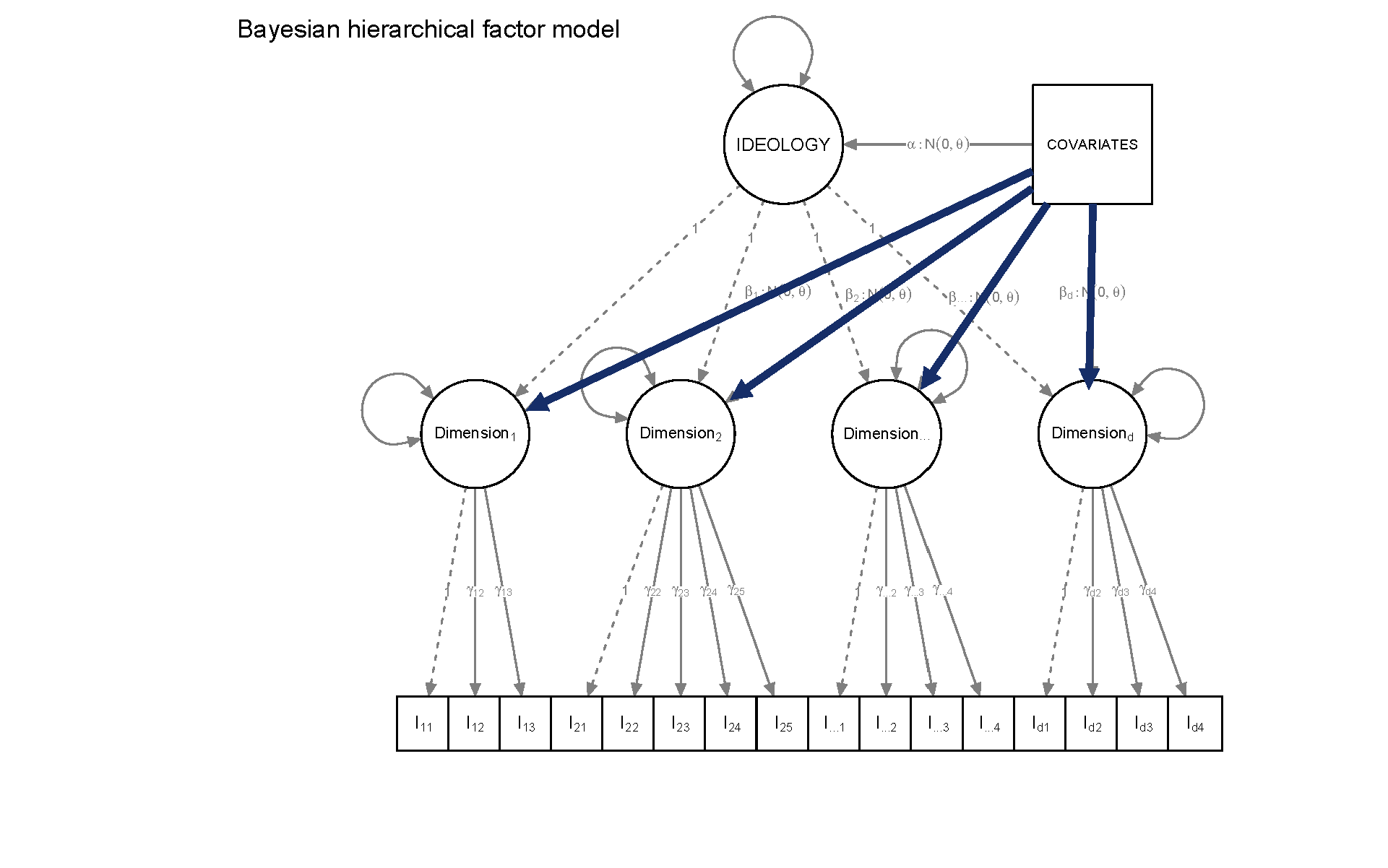
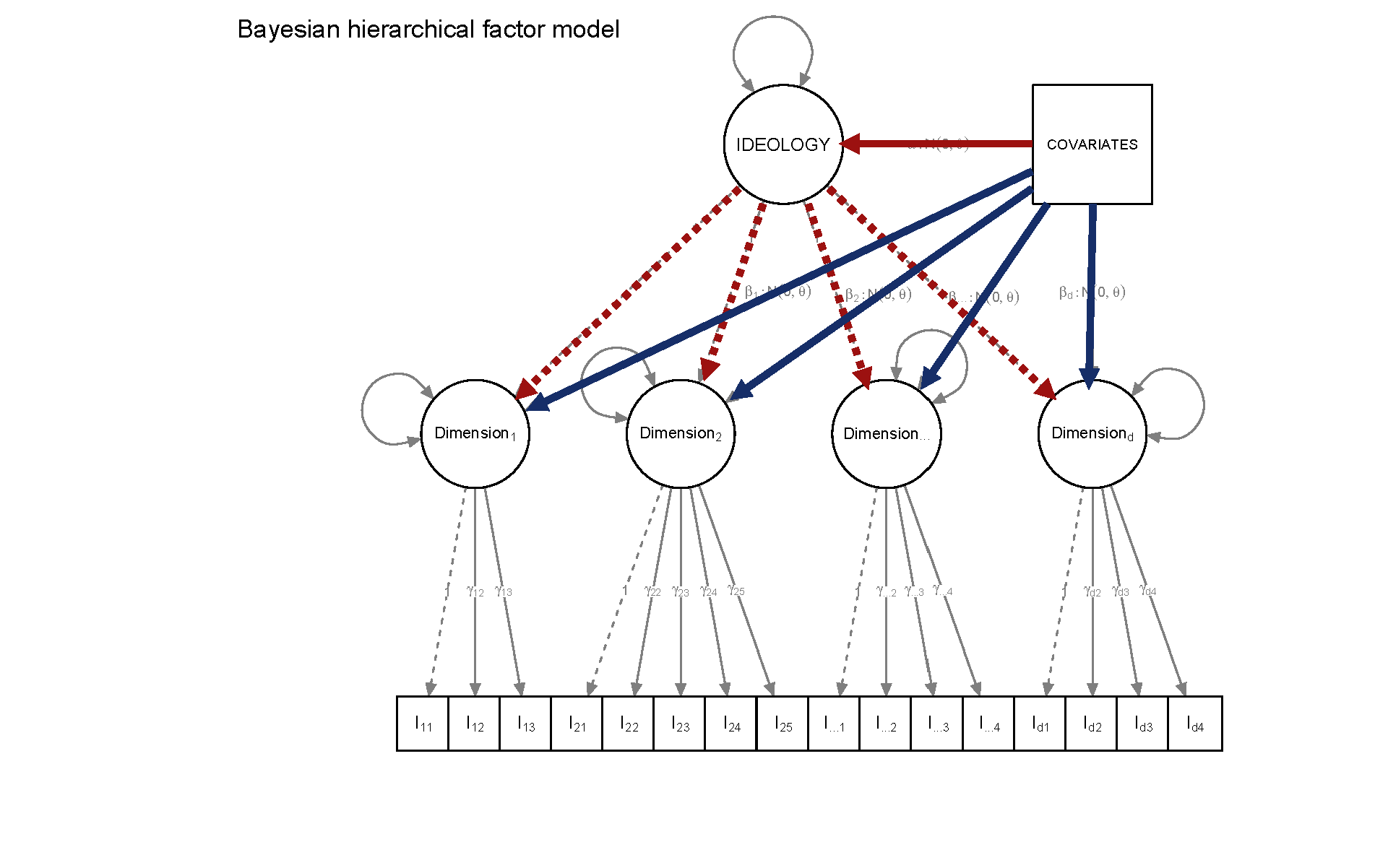
Example: Policy ideology in the ANES 2000
Selected a common set of 32 items contained across nine high-impact publications modeling political ideology based on the 2000 ANES
Inductively the dimensional composition of this item set and specify single hyper-factor accounting for latent correlation
Determine effect of various socio-demographic and psychological predictors of each sub- and the hyper-factor
Example: Policy ideology in the ANES 2000
Find evidence for six positively correlated dimensions (mean r = 0.38):
Poverty reduction measures (4 items)
New Deal issues (7 items)
Government spending on socio-cultural issues (6 items)
Civil rights and racial equality (6 items)
Moral and sexual chauvinism (4 items)
Anti-immigrant chauvinism (3 items)
Model results: Partisanship
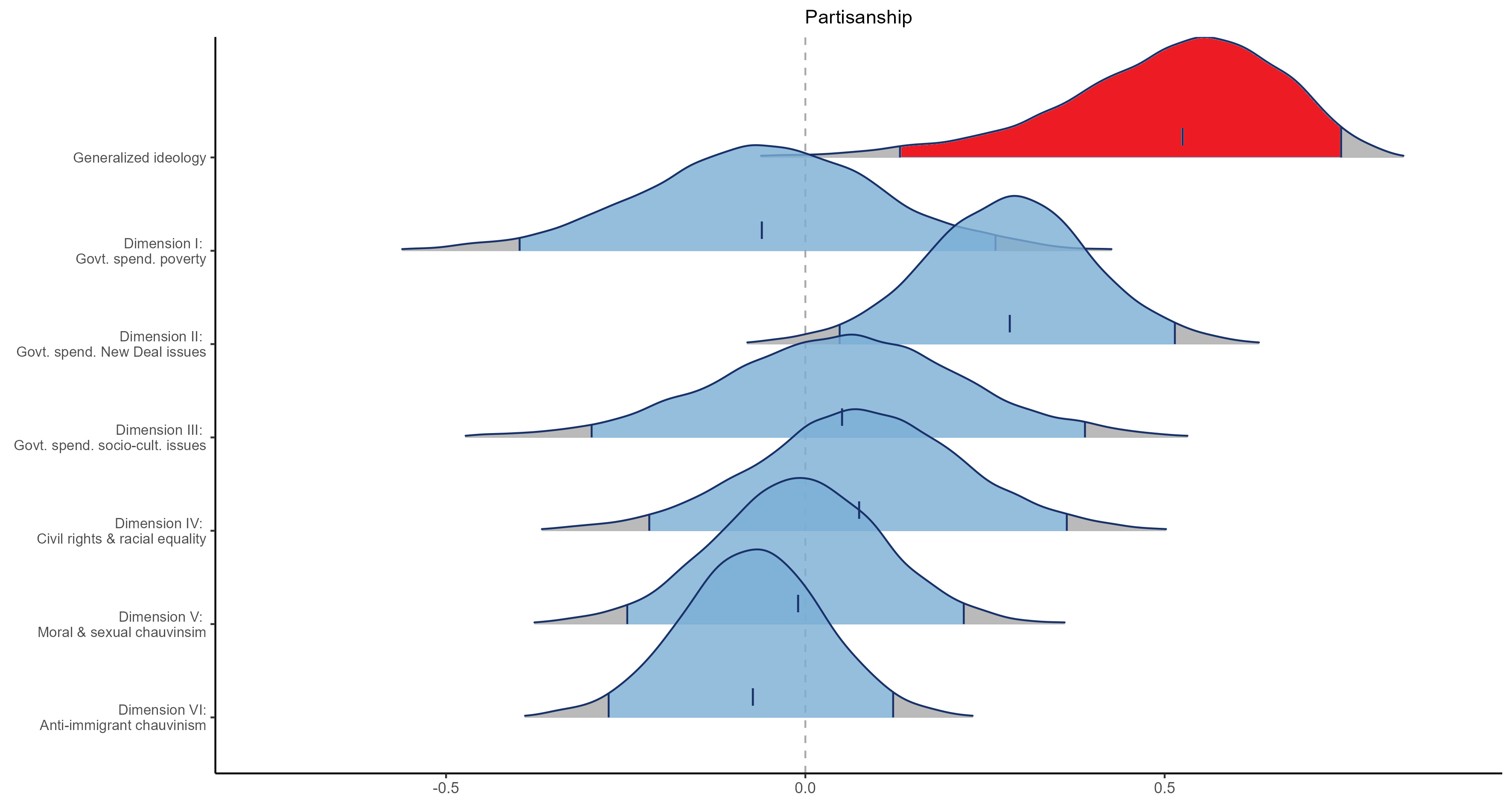
Model results: Racial resentment
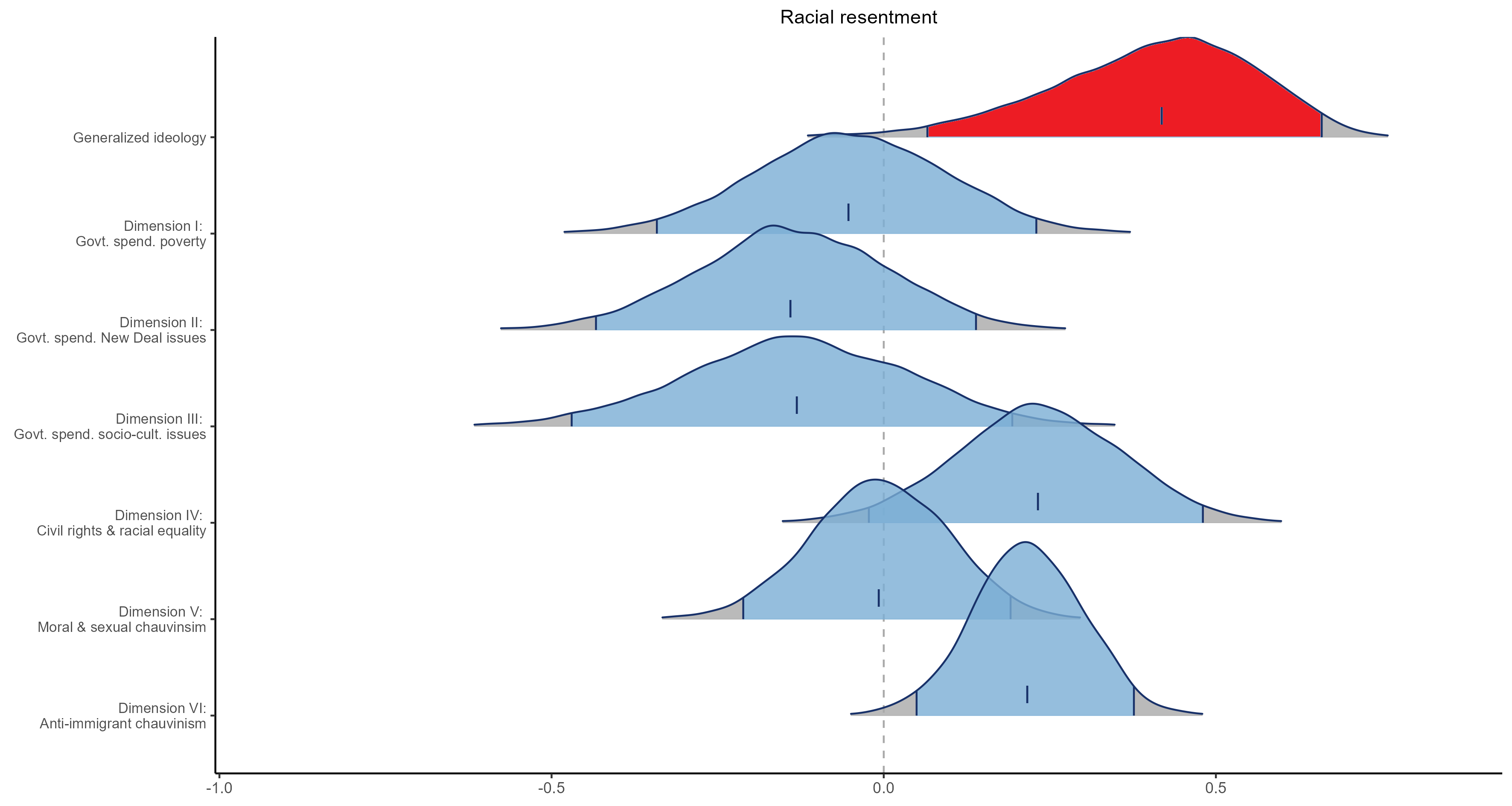
Model results: Education
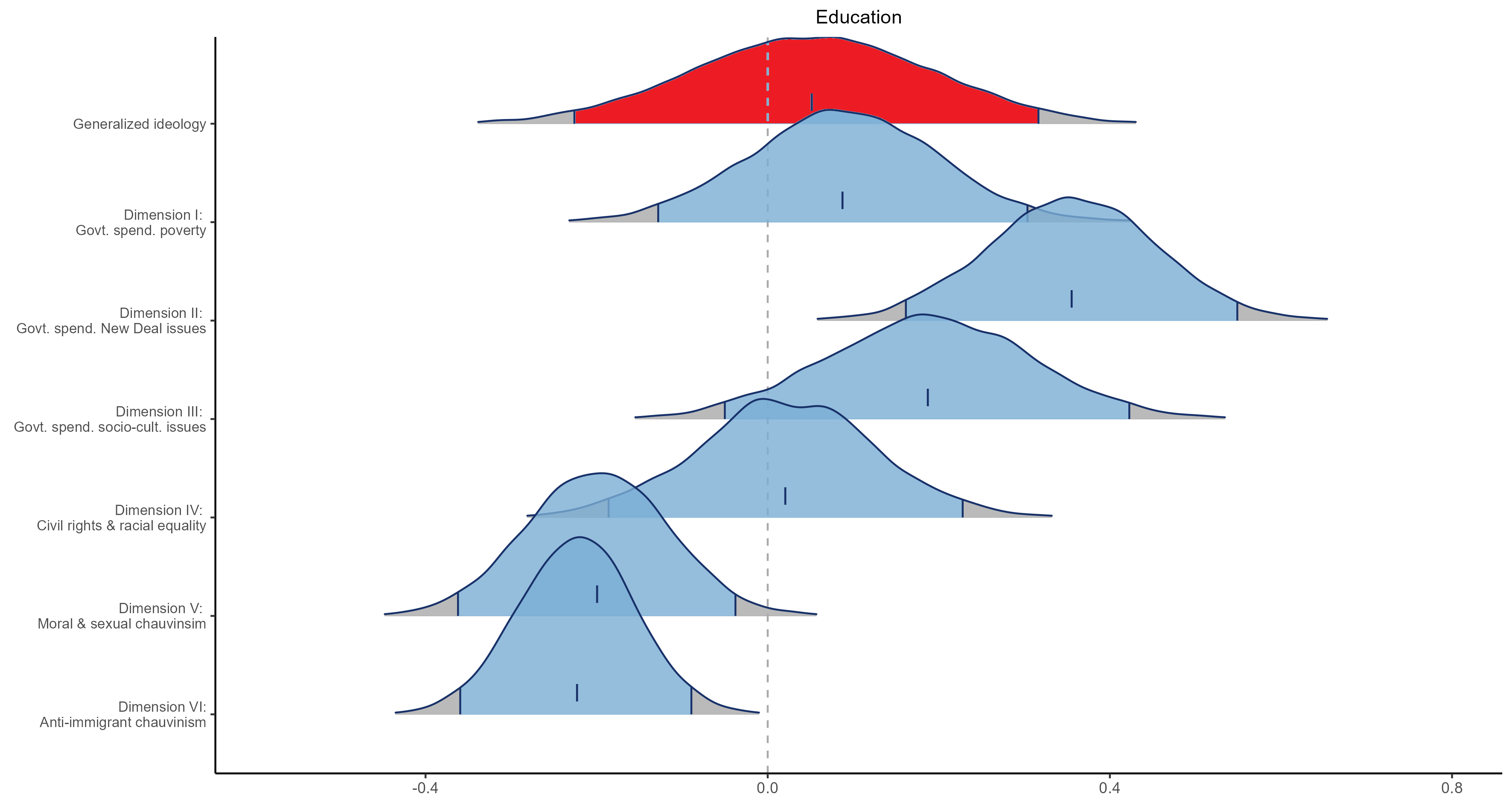
Conclusions
Assumptions about ideological dimensionality can deeply affect downstream empirical estimates
Simulation evidence across multiple ANES waves and other data sources shows that latent ideological dimensionality grows without bound as researchers select additional policy position items for analysis
Despite boundless dimensional growth, simulated models show consistent evidence for positive correlation across latent dimensions
Bayesian hierarchical model of latent ideology can account for both growing dimensionality and latent factor correlation
Further resources
The slides and manuscript are on my webside: https://philip-warncke.net/

Please leave a comment and email any advice and/or further ideas!
Robustness check: The published literature
What guidance does the published political science literature provide?
Robustness check: The published literature
What guidance does the published political science literature provide?
Key word article and academic book search with pro-quest and Google Scholar; needs to meet three criteria
Must feature at least 1 nationally representative US adult sample
Must feature at least 1 ideological summary scale with 2+ policy position items
Must be published in a peer reviewed journal or edited book
Robustness check: The published literature
74 publications between 1964 - 2023
122 unique policy ideology scales
48% in D1, 36% D2, 16% D3+
Robustness check: The published literature
